#its time for our worm overlords to take over
Text
Character Analysis: Jon Irenicus
Irenicus is a fun villain, and I think nailed one interesting element of writing down, that of bringing down the villain’s threat in an interesting and believable way. The hero typically grows in power in any story, not just in a game where your progression is literally your XP, but what the villain does, how they grow, is also interesting. If the villain is more powerful than the hero, and also does things to grow and learn, theoretically the villain should still be wrecking house. BG2 wove this into the story itself, where the more you learned about Irenicus, the less menacing he became, culminating into where he was arguably your lesser at the end: he was powerful but only aping what you were.
Obviously, spoilers for BG2 abound.
Baldur’s Gate II introduces us to our villain almost as a cold open. Fresh off the high of defeating Sarevok, you leave Baldur’s Gate after being pressured to leave by “dark forces” and by those who suspected that you shared similar heritage to Sarevok. Seems a bit odd, honestly, to oust the Bhaalspawn with suspicion given that during the course of Baldur’s Gate I, you saved two of the Grand Dukes. It’s certainly understandable that folks would fear your heritage and you’d want to move on to greener pastures, but something more than a 3-minute cut scene would have probably set the scene better.
However, this opening, and the ‘cutscene’ that follows gives Irenicus a grand initial reveal to the player. This guy is an ultra-powerful wizard, and he speaks with a clinical detachment as he states: “It’s time for more experiments.” It’s a wonderful opening to illustrate exactly what you’re dealing with. He’s clearly interested in your godly soul, and exploiting it to some unknown purpose. What is unknown, as he gets called away by some unspecified intruders by a golem. In the next scene, magical traps are set off as an unspecified Shadow Thief gets disintegrated. Story-wise, this serves no purpose, it’s purely meant to be a way to show off the new spell effects and other cosmetic changes to the engine from Baldur’s Gate II, with the disintegration dust and the screen shaking. But it does help illustrate the power level that Irenicus is throwing around. Save-or-die spells were relatively rare in the lower level of Baldur’s Gate I, even Semaj, Sarevok’s mage companion, wasn’t firing off disintegration willy-nilly. Throwing around disintegration spells clearly shows that Irenicus is a new high-level baddy. Later we see that he killed characters from Baldur’s Gate I off-screen, Khalid and Dynahier, two of the three sets of paired companions from BG1. This gives their partners reason to join in with the player character, but it also serves to show his power; Irenicus is such a bad dude that he can wipe your party before the game starts, like he was getting coffee. It might be a cruel cut, but that’s its intent, to make the player character mad at the villain, to want to punch his smarmy face in.
Commensurate in the danger of Irenicus is the need to find out what’s going on. Irenicus clearly knows something about your godly soul and so you want to find out what he knows. Even for an upstanding lawful good character, growing in power means finding a way to effect good on a larger scale, and perhaps to overcome the evil in your tainted blood. After all, no matter how good you were in Baldur’s Gate I, you still were an incredibly powerful killer. Sure, most if not all of them were bad dudes, Mulahey the iron ore poisoner, the bandits of Cloakwood, the Iron Throne and their plans to take over the Sword Coast. But chaos and destruction follow in your wake, and that chaos undoubtedly would hurt innocent civilians; Saradush in Throne of Bhaal is clear of that enough. Even just knowing more about what is going on could better prepare you for the next Irenicus or the next Sarevok.
When you go through the starter dungeon (another piece of game design, you are being tutorialized but the pastoral instruction of Candlekeep makes no sense for someone who already had an adventure), pieces of the man start to fall into place. He holds a bunch of captive dryads as concubines to remind him of someone he lost. He keeps an immaculate bedroom for a companion that is never there, with an alarm ready to dispatch the golems to kill any who cross the threshold. There’s a woman that was in his life that is no longer there, and the loss pains him, or at least, it seems that it should. Chatter with Imoen and the dryads show that this mystery man is trying to elicit feelings that he had lost, and that’s an entirely different case of worms than pining over a lost love. There’s some element of almost-unwilling psychopathy to these actions. Other hints in this dungeon illustrate this as well. His servants, discarded in vats and forgotten about entirely, would at first evoke classical evil overlords casually disregarding their own subjects. He’s almost all of the way there, but there’s enough there that the player is suggested that there has to be something more to it than that. He does seem to have some sort of sociopathy to him, where people are objects that he can find fascinating but he has no empathy. We see this later with Wanev, who Irenicus spares solely because he was hit by a spell that left him a lunatic, which Irenicus found funny, the administrator of a jail for the insane now rendered an insane patient himself.
He is powerful though, that much is clear when you break out of the starter dungeon. His display of magic collapsed part of Waukeen’s Promenade, and when the regulatory magical body of the Cowled Wizards comes to shut it down, Irenicus is capable of swatting mages like they were mosquitos. Just like the Shadow Thieves that he had been fighting, Irenicus seems more annoyed at the interruptions than any physical threat posed by his myriad foes. He’s definitely a powerful wizard, and when he finally submits to the Cowled Wizards, he does so clearly as their superior, dragging Imoen along with him. It’s fairly plain from a game design perspective what Irenicus is doing; he’s going to Spellhold so you have to get there. Good characters want to rescue Imoen, evil characters want to interrogate him to unlock the power in your blood. Either way, the player character is given a goal, and Irenicus disappears physically from the story for the moment.
He isn’t absent though. In your dreams, Jon Irenicus waxes philosophical at the player character, evoking thought-provoking questions. He explains the paradox of your existence of being born of murder, given life from the act of taking life. He speaks about accepting the gifts that will be given to you, regardless of whether or not you want them. These dream sequences are clear upgrades in quality and presentation from the spoken-dialogue text boxes from the first game after you beat major milestones. David Warner does a great job here in delivering Irenicus’s lines, he feels like a evil mentor speaking about philosophical topics with the same detachment that he tortured the player character with in the opening. While we find out later that these dreams aren’t sendings from Irenicus but rather parts of your character’s godly subconscious, they suggest to the player going through Chapter 3 that Irenicus does indeed know a hell of a lot more about you and your godly blood, keeping the player interesting in finding out exactly what it is you need to find out. The other quests in Chapter Three don’t have much to do with Irenicus, aside from some random events with the guild war in Athkatla at night, where the player will find out pretty quick that one side is powered by vampires, the level drain and click-dialogue of “your blood is rather inviting” isn’t exactly hiding that there be vampires engaged in a secret war with the Shadow Thieves. Even then, it’s tangential. You knew the Shadow Thieves were attacking Irenicus, which suggests at least some level of camaraderie with the vampires, but as we saw with the deep dwarves in Irenicus’s lair, he doesn’t care about followers, and they might simply be disposable assets if anything at all. If you want to know about Irenicus, you’re going to have to get it from the man himself.
Of course, as befits a high-level mage, Irenicus breaks out of the prison in a cutscene, kills the Cowled Wizards and goes back to whatever unsavory plans he thought up for Imoen, teleporting into the lobby and chewing the scenery with his “I CANNOT BE CAGED!” speech, reinforcing his position as the central big bad and confirming the Cowled Wizards as mere obstacles. This part of his plan has been made clear. Far from the meddling Shadow Thieves and Cowled Wizards, Irenicus can continue his experiments on Imoen in Spellhold, and it falls on the player character to go there and end it. Irenicus, of course, knows this too, and he makes sure he has contingency plans to deliver you to him. I’m of three minds on this. On one, he’s so powerful it seems that he is so powerful, and Amn so large, that plenty of these isolated areas within the continent would service just as well for Irenicus’s lair. Why waste time with all of this blah-blah-blah and just take what he wants? It’s not like teleport spells are beyond his ken. On the other hand, it’s a good way to break up into the freeform quest design that Chapter Three gives, offers the chance for your characters to level up and get cool gear, lets you rock the stronghold quests which definitely let you feel your class and increase replay value, and the idea of the forbidding wizard in the island lair is an excellent backdrop. On the third, it’s in-character for an immortal mage to have plans within plans, even to the point of complexity addiction, although his conduct afterward sort of torpedoes this idea.
That is, after he recaptures you, he immediately goes back to work to his experiments, and after another trippy dream sequence with Imoen, you find his plan. His goal is to absorb your divine soul, taking it for his own. He doesn’t explain anything more, but now that he has you, he discards you just as he has so many others. Telling his sister Bodhi to dispose of you is what keeps him from being someone like the Riddler, since he’s actually going for a proper smart villain play and killing the soulless husk he leaves behind just in case he pulls a protagonist move and comes clawing back for his stolen soul. It’s Bodhi’s instability, her desire to hunt you brought on by her vampirism, that keeps you alive. After the player character becomes the Slayer, Bodhi tells Irenicus, but true to his condescending nature, he simply...ignores the PC, writing them off as someone who is going to keel over any second due to their lack of soul, completely oblivious to the fact that Bhaal’s avatar was the Slayer, and it’s clear that something is replacing the void that he left within you. The PC must effectively turn that dismissiveness against him, by releasing the imprisoned mages within Spellhold, from the powerful but mostly harmless Dili to the megalomaniacal Tiax. Yet this hard-fought battle does not end with Irenicus’s death and your victory, instead Irenicus goes to pursue his other, as-yet unknown goals while he sends another band of cutthroats to die at your hand.
Yoshimo is sort of my feelings on this Irenicus’s Spellhold plot writ small. As powerful as Irenicus is, he really doesn’t need Yoshimo, not if he has Sarmon Havarian and so many others. Yoshimo shows up in the starter dungeon, and is useful if a bit obsequious in a “who me?” sort of fashion. He doesn’t have a really good reason to stay with the party from a story reason that he gives you. He could have said: “Hey, thanks for getting me out. Deuces!” Yoshimo’s geas gets him to want to stay with the party, otherwise he’s dead. In that sense, it makes sense for him to want to be with the group. And as the only thief who gains levels aside from the absolutely annoying Jan Jansen, he’s useful for dealing with annoying traps, because reloading a game because your main PC tripped a trap and got petrified is certainly frustrating. Game mechanics though, interfere with this. You as the player character have control over the six-person party and if you want Yoshimo to be there, he’ll be there, and if you don’t, he’ll sit in the Copper Coronet, geas be damned. He’ll stand right there until you go back in after the Underdark chapter, in which case he flops over dead and hardly anyone cares. That’s a system engine limitation certainly, but it’s remarkably clumsy. What is good though, is Yoshimo’s regret during this. He knows he has to betray you and is forced to do so, and he genuinely likes you. The writing that happens is crisp, Yoshimo truly does apologize and Irenicus backs up his dismissive assholery by telling him to shut up. When Yoshimo confronts you in Spellhold, his writing is crisp. “No redemption, and no second chances. My heart to Ilmater.” He fights you and goes down swinging (which was annoying the first time I played because he had the Celestial Fury +3). And you can actually take that heart to Ilmater, occupying a valuable inventory space through the next chapters until you can reach Waukeen’s Promenade again, where you can choose to forgive him or not, but give the heart to Ilmater either way. It would have been saccharine to restore Yoshimo, but this way, I feel, is more powerful in a world with such powerful enchantments to see the effects on the people whose lives it ruins. So the game can be clunky at parts, and Irenicus can be as well, but there’s true craft and joy in it.
Back to Irenicus though, we get the sense of more to him when we see the intro splash screen for the next Chapter. Making a dark bargain with the drow, we see that they have captured surface elves, one of whom immediately refers to Irenicus as Joneleth, suggesting a backstory far deeper as Irenicus immediately resorts to killing the prisoner after being the one to suggest interrogation instead of immediate execution, a lashing out that seems out of character for the clinically-detached evil villain we’ve been coming to know. The backstory is clear in the Forgotten Realms, the dark elves and surface elves are mortal foes and anyone who is known to the surface elves to ally with the dark elves is a great betrayal. As the PC goes through the Underdark and comes out, they are captured by the surface elves. Through a conversation with Eldoth, it can become evident that the surface elves know more than they are letting on, such as when they are the ones who suggest holy water and stakes to fight Bodhi, despite not knowing anything about either one of them. After you slay Bodhi and restore Imoen��s soul to its rightful place, you can call Eldoth out on it. Irenicus is “the Shattered One,” an exile of the elves, and it’s here that Irenicus’s story becomes apparent.
Irenicus was a powerful wizard and lover of Queen Ellesime named Joneleth. Yet in his heart, Joneleth yearned for more power and sought to take the essence of the Tree of Life, the lifeblood of the city of Suldanesselar, for himself and Bodhi. This dark ritual nearly killed many that existed within Suldanesselar, and so Joneleth and Bodhi were punished, stripping their elven nature and immortality away from them, leaving them with a mortal lifespan, thus Joneleth became Jon Irenicus, the Shattered One. Bodhi sought to become a vampire to transgress the mortal years she had, but Jon had felt that it degraded her to that of a high-functioning beast. Irenicus’s scheme was far more grandiose if also possessing an elegant simplicity: he lost an immortal soul and so he needed to take one for himself. The Bhaalspawn was the perfect choice, powerful enough to defeat Sarevok and awaken the power within, weak enough to be captured and have the divine soul snatched away. With his stolen soul freshly acquired, Irenicus now looked to the second part of himself, to revenge himself on the elves. The dark elf invasion ultimately failed, helped out by the PC butchering the leadership of Ust Natha, but Irenicus is still going with golems and summoned demons to destroy the city, usurp the power of the Tree of Life, and complete his long ago schemes.
I... I do not remember your love, Ellesime. I have tried. I have tried to recreate it, to spark it anew in my memory, but it is gone... a hollow, dead thing. For years, I clung to the memory of it. Then the memory of the memory. And then nothing. The Seldarine took that from me, too. I look upon you and feel nothing. I remember nothing but you turning your back on me, along with all the others. Once my thirst for power was everything. And now I hunger only for revenge. And I... WILL... HAVE IT!!
When confronted by Queen Ellesime, she even asks if there was any part of him that remembered the love he had for her, and the PC sees that it’s her that was in his mind for the beautiful bedroom way back in chapter one. It was almost certainly her that Irenicus thought of when he was with his dryad concubines. And when she poses that question, he answers with the above quote, that he feels nothing. While it seems like this is a loss of depth, that he’s just a flat character, I don’t think this is the case. Irenicus had the chance to change, for self-reflection. Instead, he remembers it as all the others turning their back on him, without any recognition that his schemes nearly killed them. It’s the classic abuser mentality, how dare you make me do these things to you. When his victims tried to defend themselves, he lashed out and remembers only their ‘cruelty’ to him. It’s this that makes Irenicus, for all his great arcane might, so small. Where before he was this intimidating figure, now he’s a petty man, and fittingly, it’s here that you can kill him. Temporarily, at least, because there’s still one more dungeon. Irenicus and you are still battling for your divine soul, and after a few self-reflective quests of your own, you duel Irenicus, who dies pitiably, torn to shreds by demons as his power fails him. It fits the heroic and thematic heft of the arc. As you grow in power, Irenicus diminishes in threat. He was your torturer, an inhuman menace, then he became just a man, torn apart by tiny demons that you probably could take down by the truckload.
There’s good things to learn here. Irenicus isn’t a super-unique villain, although some of the villain tropes are personalized for the sake of the Baldur’s Gate story specifics. But he does his job admirably. David Warner’s voice work, and the special effects (pretty good for when the game came out in 2000) really was able to sell Irenicus as an enjoyable villain.
Thanks for the suggestions, Anons who were looking forward to this.
SomethingLikeALawyer, Hand of the King
67 notes
·
View notes
Text
Daylight and Dark Ch. 2 - Morning
You can find Chapter 1 or read the entire fiction on AO3 HERE.

CHAPTER RATING: Teen; FULL FICTION RATING: Explicit.
WARNINGS FOR ENTIRE WORK: violence, sex, language, references to prior domestic abuse, and rock n’ roll!
CHAPTER WARNINGS: Mom Friend Minion is too damn loveable
Roxanne woke with her head pillowed on Megamind's shoulder. She blinked blearily in the bright sunlight filling the room, and stretched delightfully sore muscles. It had been too long since she'd last awoken with the afterglow of good, rough sex warming her body.
"Good morning, Beautiful," said a smooth, pleasant voice.
Roxanne smiled up into Megamind's handsome face. "Good morning," she sighed, sliding against him to kiss his mouth. She settled back beside him, nuzzling the side his neck and idly sliding one finger up and down his opposite ear. "Mmmmm, I should get up, but I'm much too comfortable."
"Then don't get up."
"But I really should."
"The Evil Overlord forbids it."
"You're not an Evil Overlord anymore."
"Well, then the Defender of Metrocity forbids it," he grinned down at her, turning to wrap both arms tightly around her. "Stay with me," he added seriously. "It's Saturday. As long as I'm not called to duty, there is no good reason why we can't spend the whole day here."
An electronic buzzing suddenly disturbed the quiet. It was quickly joined by a metallic rattling at the window. Roxanne bolted up in bed, giving a little yelp and pulling her coverlet over her chest as she realized six or seven brainbots were swarming outside the glass. Megamind's reaction was even more animated. He practically tumbled onto the floor, bringing the rumbled sheet with him and wrapping himself frantically in it. He stumbled to the window and, ignoring Roxanne's stuttering protests, threw it open to let the little flying robots in. They massed around him like worried children, bumping him with rounded glass domes and pawing him with long mechanical arms. Roxanne was sure that if they'd had tails, they would have been wagging.
Chuckling nervously, Megamind patted them. "Okay, okay, Daddy's alright. This is just Daddy's… ah… private time… So we really shouldn't be bothering Daddy. No we shouldn't." He shook a finger at them to emphasize his words, but that caused the sheet to slip a little, and he snatched it back up into place. "Look, Daddy's not leaving you behind. Daddy just needs to spend some alone time with Roxanne, okay? Daddy loves both you and Roxanne, but in very different ways…"
Roxanne nearly choked on her giggle. Of all the absurd things she had seen him do during her semi-professional Damsel-in-Distress career, none were quite as funny as Megamind giving the Daddy Has a Girlfriend speech to a hoard of cyborg drones. Her humor was stolen, however, when one of the brainbots left the happily swirling flock to hover in front of an empty section of wall. Moments later, the top minion— or rather Minion— appeared, his image projected by the brainbot's red camera eye. Roxanne blushed bright scarlet and tugged the blanket higher. She knew enough about Megamind's technological creations to realize that Minion could see them just as well as they could see him.
"Oh, sir! Thank goodness they found you! I've had the brainbots looking everywhere! Where have you been all night?!"
"Here."
"No phone call? No message? You just stay out to all hours—"
"Minion," Megamind interjected. "This really isn't the best—"
"Without a single thought of what you might be putting me through—"
"Minion—"
"...worried sick, and—"
"Minion!"
"WHAT? I mean…Ah... What, Sir?"
Megamind took a deep breath and began gathering scattered clothes from the floor with one hand, the other still clutching the sheet tight. "You're right. I should have called. I didn't think about it—"
"Didn't… didn't think about it?" Minion blustered, wide-eyed. "Sir! How could you? After all we've been through! You… You know that my sole purpose is to take care of you, and… and…"
"Oh, Minion! Stop being so dramatic! You know very well I didn't mean it that way!" Megamind threw up his free hand in exasperation, flinging his shirt above his head.
"How did you mean it, then?"
Another deep breath and Megamind collected himself. "I got a little caught up in the moment and… things…"
"Things? What things?! That's no excuse!"
"Things, Minion," Megamind said pointedly, motioning his head toward the bed. "And this seriously is not a good time."
Minion glanced where his master indicated. "Oh good morning, Miss... Ritchi..." his cordial voice grew faint as he finally took in the scene. Large aquatic eyes bulged, flitting between Roxanne and his master.
"Oh, Sir! You didn't!"
Megamind rolled his eyes and snatched one of his boots from the floor. "Yes, as a matter of fact, I did."
"Sir!"
"And I plan to do it again!"
"But Sir!"
"A lot!"
"SIR!"
"As often as possible!"
Minion mouthed wordlessly before shaking himself free of shock. "Well, I just hope you're being safe," he quipped in a tone that sounded entirely too matronly.
Oh, dear… thought Roxanne.
Megamind had paused instantly, mouth open to offer a retort that never came.
"Oh, sir," Minion repeated, groaning in despair. "You didn't…"
"I… didn't think… " He gathered himself visibly. "Look, Minion, it's doubtful our DNA is even similar enough to be compatible!"
"You can't know that without tests!" Minion objected, then asked hopefully: "have you run any tests?"
"It's on my to-do list!" Megamind announced defensively.
Minion clapped a mechanical hand to his fishbowl. "This is a disaster..."
At least here Roxanne could help. "It's okay, Megamind, Minion. I'm… Uh…" she shrugged, fighting the burning heat in her face. "On the pill."
The entire room seemed to sigh with relief.
"Well, thank goodness one of you has some sense!" said Minion pointedly. "Sir, I am very disappointed in you."
Megamind spoke through gritted teeth. "Could we discuss this later?"
"No, we can NOT discuss this later," Minion replied in his best parental tones. "Sir, you have a reputation to uphold now, and—What are you doing?"
Megamind had walked up behind the hovering brain bot, tucking the edges of the sheet tightly under one arm, and started fiddling with something on its back.
"I understand," he sounded bored. "Reputation. Yes."
Minion's eyes narrowed, his tone slow with barely restrained suspicion. "With all due respect, Sir, if you're doing what I think you're—"
"What was that Minion?" Megamind called loudly.
"Sir, leave that audio-visual receptor alone!"
"I can't hear you!"
"Stop that!"
"There seems to be a problem with the receptor!"
"Problem with—That's because you're messing with it!"
"Minion? Ollo? If you can hear me—"
"Of course I can hear you!"
"…I'll talk to you this afternoon when I get home!"
"Sir! Don't you dare turn off that—"
The image went blank.
Megamind heaved a great sigh and idly petted the brainbots. Then he walked to the far side of the room, where he had thrown his collection of clothing, and awkwardly held the sheet with one hand while fumbling with his leather pants. He extracted his wallet and turned back to the brainbots.
"Here," he said, holding out a twenty-dollar bill. "Daddy needs you to take this, go to the bait shop, and buy Uncle Minion something nice. Some juicy worms or maybe some minnows. No, no, no," he admonished as one of them snapped at the money. "Not for chewing. Daddy will bring you a new wrench to play with when he comes home. Now go get Uncle Minion a treat."
The little robots circled him once by way of a goodbye, the lead one obediently taking the money in a dangling claw, and flew out the window. The last one ran into the windowsill, and Megamind sighed, scooped it up, turned back on its electronic eye, and patted it. It sped out the window, chattering irately at its receding fellows. Roxanne could almost imagine a running child shouting for his friends to wait up.
"Well," Megamind said, slumping to the bed. "That certainly woke me up. Maybe it would be simpler if you stayed over at the Lair next time." He grinned suddenly, his lightning-quick thoughts leaping to a new subject. "I'm starving! Where's that lasag-na?"
"For breakfast?"
"It's nearly eleven! Besides, it's better than cereal and wine."
Roxanne laughed. "I guess I can't argue with that." She sighed and got up, pretending not to watch Megamind as he dropped the sheet and began pulling on his clothes.
Megamind, thoughtful as ever, had put the food into the refrigerator sometime during the night. The salad Roxanne had made had wilted, but the lasagna was wonderful once reheated. Sitting on the small balcony outside the glass double doors, they enjoyed the pleasant, invigorating bite of the autumn air. Megamind ate voraciously, but then, Roxanne supposed, he had gotten quite a work out the night before.
That thought made her chuckle.
"And just what do you find so amusing, Miss Ritchi?" he teased in that heart-melting tenor of his.
She looked at him, adorably happy with his favorite food and his favorite girl. It took so little to please Megamind sometimes, and his exuberance, coupled with his persona as a dark superhero, seemed both oxymoronic and oddly fitting. It was… relaxing and somehow comforting to be around someone who was so content.
"Has anyone ever told you you're cute?" Roxanne asked, dishing out another serving of lasagna to him.
He grinned at her. "Yes, actually. An inmate in Metrocity Prison when I was a toddler. His name was Kip Kendall— or at least that's what people called him. I'm not sure if Kip was a nickname, honestly. He'd been convicted of murdering some thugs who got on his bad side, and he was very possibly the toughest, meanest brute on Cell Block A. But he was always nice to me when I was young. Around anyone else he was stern and dangerous… Around me, well, he was the closest thing to a father figure I had. He used to play pattie-cake with me, if you can believe that, and carry me around the Yard on his shoulders. No one dared to mock him for it either— not even the guards— and if anyone thought less of him for it, they were smart enough to keep it to themselves." His eyes grew distant as a sad memory ghosted behind them. "I'll never forget the day Uncle Marlow—one of the other two inmates who took the most interest in my upbringing—took me aside and explained that Uncle Kip had gone. Kip had been given consecutive life sentences by a jury too forward-thinking to give a clearly unbalanced man the death penalty, but Cancer had other ideas. I'd known he was sick— they'd had to take him to the infirmary, and the last time I visited him there he seemed so… so unlike himself— but when he went it still felt… wrong. Sudden. I remember thinking how unfair it was that he left without saying goodbye."
Roxanne reached across the table, laying her hand over his, willing him to open his soul and let the old pain dissipate like dark mist in the sunlight.
"I remember feeling that way when—" Roxanne's voice caught. She'd never actually told anyone else this before. Not even the expensive psychologist her grandparents had taken her to for years. With a deep breath, she continued. "I remember feeling that way when my mom died. I was fifteen, in my senior year of high school, and someone told me I had to go to the principal's office. I kept thinking and thinking, trying to figure out what I'd done wrong, and then I saw Principal Hartwell's face. The school counselor and my granddad were with him. And I knew. Somehow I just knew," she paused, wrapping her arms around herself and staring at the glass tabletop. "I started crying before they could even tell me, and I kept asking how. I remember someone saying something about icy roads, and dozing off at the wheel, and how it was no one's fault. I hated that person for saying that. I wanted it to be someone's fault, to be able to blame somebody. I wanted to blame the car company for not making her sedan stronger, or the hospital for making her work that stupid double shift, or my sperm donor for leaving us so that she had to work so many hours in the first place. But more than anything else," she dared to lift her eyes to his, "for a long time, I wanted to blame her for not saying goodbye."
Megamind stood up and moved beside her chair to wrap one arm around her shoulders. She leaned into his warmth, laying her hand on his.
"I'm sorry," he said. "I had already left Metrocity High School by then. If I had known... I would have been there."
Roxanne laughed a little through her sorrow. "Yeah, that would have gone well... The city's new supervillain showing up to offer a spikey shoulder to cry on." She sighed and squeezed his hand. "You know you couldn't have, no matter how much you might have wanted to."
"I would have. I loved you even then, and I would have done anything for you." He kissed the top of her head. "I'm so sorry you lost your mother that way."
"It's alright. I mean, it's not alright, not really, but… It was a long time ago. I still miss her, but I've kept going. I've built a life for myself, just like she would have wanted." Roxanne sighed, but the sound held more relief than sadness. "You know, it's kind of nice to finally talk about it."
Megamind bent to lay his cheek on top of her head. She could almost hear the gentle smile in his voice. "It's nice to finally have someone to talk about it with," he said.
#Megamind#megamind fanfiction#Megamind fanfic#fanfiction#fan fiction#fan fic#fanfic#Megamind movie#Roxanne#Roxanne Ritchi#mystery#superheroes#superhero#crime fighting#Metro City#Minion#Defender of Metro City#Metrocity#humor#romance
13 notes
·
View notes
Text
Here’s my secret santa gift for azzy_j!! I hope you like it!
This short story happens sometime between the end of AoR and the beginning of the move. The Emperor is starting to show signs of decay and skekSil sees an opportunity ...
Eternal Reign
Single file and robed in black, a procession of podlings walked through the halls of the Castle of the Crystal. The first held a lantern followed by another carrying a tray of chalices. Not far behind came more, carrying massive platters of food. They walked an unbent path as if all pulled by an invisible rope. But the pull was inside their own being, their spirits bound by the will of their captors, the Skeksis.
With pale heads bowed and unblinking eyes, they turned through an archway and into the grand banquet hall. The room was dark with no windows, only lantern light. It cast shadows on the faces of their overlords and glistened on the food. Echoing off the black stone walls was the shouting of jubilant Skeksis.
“Music!” one of them yelled over the others.
Hollow eyed musicians in a balcony began to play. The droning rhythm mixed with Skeksis voices. It did not sound like podling music but like slow thunder trapped in tin horns and drum skins.
The low rumble pleased the diners who cheered the sound from their seats at the feast table.
Then they added their own percussion. Their meals were the instrument with shells and tiny bones cracking and snapping in gnashing teeth. Long spiraling sinews of meat twisted round clanking forks, disappearing into slurping jaws. A groan of delight came from the Gourmand as he pushed his nose into a bowl of worming morsels. Defensively they released a spray of venom. The tang of their desperation was pleasing to the pallet and with a cupped claw he led them into his open mouth, finishing with a burp.
The decadent feast held the attention of the other Skeksis, but skekSil had his eyes on the Emperor. He grinned, glad to be seated by his side.
A charred tentacle sat on a plate before the great ruler. He struggled to sink a knife into the meat. The dead thing remained defiant, not yielding to the all powerful Emperor’s blade.
“Ahh, please,” skekSil said, “let me.” And reached over to offer assistance with cutting skekSo’s food.
“Arghrrr, No!” the Emperor growled, shoving away the Chamberlain’s crimson sleeve.
Slamming the knife to the table, skekSo grabbed up the meat and began tearing at it with his beak.
Unbothered, skekSil leaned back and tilted his head. It was a weak display of rage. Lately some mysterious ailment had enfeebled skekSo. It was strange seeing the Emperor in such a state. SkekSil watched him struggle as he chewed. Then turned his head to view others at the table.
What would they do if skekSo continued to decline?
There were few worthy rivals and many pieces on the board. For a wise Skeksis like the Chamberlain each could be easily moved. Cleared away to make a path to power.
The Skeksis who were new to the castle had their roles. Any aspirations they might have could be quickly dashed. The Garthim Master and Slave Master may rule their charges but, in a way, were also ruled by them, and ever occupied with inferior creatures. The Emperor would not put trust in those who spent their days with filthy slaves and monsters.
SkekSil remained the most civilized of their kind, a Skeksis cunning and worthy. Should the claw that holds the scepter weaken, its grip fade and fail, none would be better to take it up than loyal skekSil.
Mmmmmmmm, a giddy whine escaped his beak.
Then a dirty podling hand placed a chalice before him. The servant moved on, placing one before each of the Skeksis. Claws all around eagerly grasped at the cups.
And, as if he had willed it, an opportunity presented itself.
“Waiit!!”
All raised their beaks at the Chamberlain’s outburst.
“This is special meal, yes? Must say a few words,” he looked to his side as he rose from his seat. “I’m sure Emperor agrees.”
“Hm?” skekSo replied, having not yet swallowed his first bite of meat.
“This day, and so many days before, Garthim have captured no gelfling. Is clear, quite clear, none remain! These most vile creatures have been eradicated from our world. Today we drink podling essence and celebrate gelfling annihilation!”
SkekSil raised the chalice. He posed belly puffed forward, chin jutting out proudly. The posture of a leader.
“Our reign will be unending! Our power unmatched! We drink to magnificent victory, to our brilliance and our Emperor!”
“Are you finished?!” skekUng snorted.
“Mmmmmm,” the Chamberlain sneered.
“To the Emperor’s eternal reign!” the Ritual Master shouted, raising his cup as he stood, neck outstretched to emphasize his height.
The other Skeksis raised their chalices for barely a moment, then gulped down the essence. SkekSil never took his eyes off his rivals as he drank it down.
The Ritual Master was a fool - so bitter, so desperate for power, sad. SkekSil had to be sure he would never have the Emperor’s trust. And skekUng, deceitful and foul, most ugly of Skeksis. He would pay for his interruption.
Soon there were snickers and laughter as the essence kicked in. It was not crisp and clarifying like gelfling essence but mind muddling, more like a spirit. Still it gave them strength.
For a moment, SkekSil had stood with power. Moments like these would build over time and plant ideas in minds which would grow into truth. Each show of strength was a step on his path to future glory.
Then he heard the Emperor gasp and cough. Excitement cut through essence induced haze. Skeksil turned to face the sound.
“Drink slowly sire,” he said.
The sound had been music to his ears. A plan was coming together. Later alone he would toast to himself, and his impending reign. The feast was such a fine night. He could nearly feel the weight of the scepter in his hand.
8 notes
·
View notes
Text
Spoilers.
Okay I can’t hold it in anymore, I need to yell about Star Trek.
SO.
In light of the revelations we got from Picard ep8 and ep9, I have come to the conclusion that the plot is a giant fucking mess. Lemme explain.
(Buckle up, it’s long and VERY spoilery).
First, a recap: 300 000 years ago, synthetic lifeforms from another galaxy dragged eight suns together (or maybe created them) and put a sign on the planet in the middle, saying “hey synth pals, when the organics decide to destroy you, give us a call, we’ll destroy them.” The Romulans stumbled upon it, understood only the “synth, organics, destroy” part and decided to hunt and kill robots before they evolved. So far, the robotic higher beings have only succeeded in making the organics hate the synths, so good job.
Using the Romulan rescue, Oh makes synths illegal through the attack on Mars, causing the death of most of her people (and incidentally, of the entire Vulcan race in another timeline. Thanks, Oh!). I’ll give her points for dedication, at least this isn’t a “save my people and screw the rest of the Federation” scenario. She’s actually willing to sacrifice her planet to save the whole galaxy. (Doesn’t make it moral, but still, pretty selfless, in a dark a twisted way.) Again, this is the robotic higher beings’ fault.
Moving on, The surviving synths try to make first contact with Starfleet, resulting in the death of Jana, Beautiful Flower and Vandermeer, which has overall very little consequence on the bigger plot. AGAIN, this is indirectly the robotic higher beings’ fault. (Maybe losing her sister is what makes Sutra such a bitch? Don’t think so though, we’ll get to that.)
Maddox, learning nothing from the Ibn Majid, decides to learn the truth about the ban and sends two synthetic girls that look exactly like Jana to investigate (my god is he stupid), while not actually telling them what it is they’re supposed to find (oh, Bruce. Oh my god). It leads to the Romulans realizing that there’s an entire planet of synths. Outstanding work, dumbass.
Picard does his thing and decides to save the synths and advocate for their lives, Sutra realizes what the Admonition actually meant, and decides that killing all the organics sounds like a great idea. She doesn’t hesitate to let Narek kill one of her sisters to unite her people, showing that she’s exactly the same kind of psycho bitch as Oh. The problem is: SELF-FULFILLING PROPHECIES. The robotic higher beings are fucking IDIOTS!! They’re supposed to have seen many civilisations rise and fall, so they should know what to do and what not to do, and their rational still is “organics will kill us anyway, so let’s kill them,” leading to the organics being like “oh shit, the synths want to kill us, let’s stop making them,” leading to Sutra being like “welp they’ve already started hating us, our robot overlords were right, let’s kill organics.”
OH. MY. GOD!!!
I get that the lesson is that fear is the great enemy, and in this case it’s really well demonstrated (gotta give credit where it’s due), but still! It’s so frustrating!!
My biggest problem with that convoluted plot is that we (the viewers) are supposed to see the synths as the organics’ equals. Their plight is supposed to be equal to the Federation’s. Except NO. I’m sorry, NO.
(More on in-universe morality and out-of-universe viewer experience under the cut, because I took pity on your dashboards.)
I get wanting to survive from the Romulan attack, okay. (There is la Sirena for that, just as a reminder.) But Sutra saying that the Federation banning them was essentially genocide? NO. They are made. They aren’t born naturally. A government telling its people to stop making procreating isn’t the same thing as a government killing every kid younger that ten! Parents refusing to conceive isn’t the same as murdering their children (I won’t open the can of worms that is the abortion debate, the point stands).
We as an audience are still supposed to see the Zhat Vash as the bad guys, because Oh, Narissa and Narek are villains, and because they have caused untold suffering. (By the way, linking Cris’ personal tragedy to the synth crisis is a massive plot contrivance to make us hate the Zhat Vash more, which I found frustrating watching ep8. Losing people in a horrible way happens even without grand global conspiracies, and Cris had already been established as going out of his way to help people even when there was nothing in it for him. We didn’t need the connection to empathise with his pain, and he didn’t need the added incentive. Seriously, how small is that galaxy? Are everybody’s demons linked to Picard’s heroic quest? How convenient.)
But are the Zhat Vash really the bad guys? (Even Cris questions that despite arguably being the Sirena crewmember who as per ep8 had lost the most because of them, along with Elnor.) I’m sorry, if Sutra does try to call the robotic overlords, I say burn Cappelius to the ground.
Lemme continue to explain. There are what, 50 synths? 50 robots. And the show tries to make me (again, the viewer) accept that risking the survival of the entire Federation (trillions of people) to save them is actually a question worth asking? From an in-universe moral standpoint, perhaps.
From an outsider’s perspective (the audience), not even close. Robots having souls and being equal to humans isn’t even a discussion we’re having in real life. I don’t believe androids will ever be self-aware, and capable of emotion and love. Sure, in the Star Trek universe they apparently are. So what? Suspension of disbelief only goes so far. The show can’t expect me to accept that many IFs. I get the very one-the-nose “fear of the Other,” “make love not war,” “different races have equal rights to life” analogy. The message is very much worthy, the show’s depiction of it really pisses me off. The show isn’t asking me to decide whether or not it would be moral to kill the last survivors of a human (or even alien) tribe to save the world, it’s asking “but what if we were basically God and we fucked up, how would we fix it? What if the stuff we made eventually had feelings? Then it’d be bad to destroy it, right?”
Aside from the sheer hubris of that premise, I don’t know that the robots have feelings. I know it looks like they do, and that they believe that they do, but again, how am I to know? From a biological viewpoint, they’re certainly not alive:
“Life” (biological def taken from the web)
Definition. noun, plural: lives. noun, plural: lives. (1) A distinctive characteristic of a living organism from dead organism or non-living thing, as specifically distinguished by the capacity to grow, metabolize, respond (to stimuli), adapt, and reproduce.
Do the synths grow? Nah. Do they metabolize? Yes. Respond to stimuli? Yes but debatable as it’s programmed. Adapt? Yes. Reproduce? NOPE.
2.5/5 on the living scale lol. That’s not that great. (From an in-universe moral perspective, this time. I know, TNG did an ep on that, sorry.)
Still the show tries reaaaally hard to sell their sentience, and the one time that really didn’t sit well with me was that “robotic finger touching the human finger” image. WOW, last place where I expected to find religious imagery, a show that questions what it means to be human and what creating beings in our image would entail *sarcasm*.
Except they twist the imagery. In the Bible, human lives are sacred because they are in the image of the perfect God, and He values us (=> so human worth come directly from God attributing worth to us because we’re meant to reflect His goodness).
Humans being imperfect due to their fall, creating something in their own image is called an idol - it’s a false god, it’s not sentient, it’s even more imperfect, and it’s wrong. And if humans don’t value it and and it doesn’t reflect who they are anymore, well, it would make the idol even more worthless, right? (clearer explanation because my arguing skills suck => drawing on the Bible’s imagery, either humans are not gods and the images they created are worthless, or the series means for them to have God’s place, in which case refusing to attribute worth to their images makes those worthless. That invalidates the question that I previously said the show was asking.)
So all in all, reminding us of the Christian take on the issue right in the middle of the Admonition claiming that synths are perfect is thus completely counterproductive, both in universe and from a viewer’s pov.
But but but, I hear you protest, what about Data? He had worth!
This may be controversial, but Data mattered to us because of the character he was, not because he was supposed to be human. He was adorable and losing him meant losing an interesting and enjoyable element in the show, which would make us sad. I love him like I love Cris’ holos, the Voyager Doctor, Wall-E and Eve, R2-D2, Jarvis and Chappie. They’re (very) likeable fictional creatures that can be used as metaphors for real life issues, nothing more. In any show/movie I’d be really sad if one of them had to be sacrificed to save the world, but I’d accept it (looking at you, Infinity War Captain America). If the question arose in real life, would I question the morality of it? No.
So, are the new synths the same? I already tackled the metaphor thing, it’s not handled that well and Detroit Become Human did it first. (Again, it’s hard to portray the otherness of other real life-cultures that we may unjustly fear by using things whose living status is so easily questionable!!)
Is killing off the synths wrong from an out-of-universe perspective because the audience loves them? Let’s see... Are the new synths adorable/likeable? Heck no, give me Emil and Enoch over them any day.
Would we lose something in the show if they died? Nah. We didn’t even know they existed until one episode ago. Picard would get angsty and Agnes would get upset, but it’s nothing a few fluffy fics wouldn’t fix.
Do we know the synths as characters? We know that Sutra is crazy, violent and bloodthirsty, Jana was probably nice (?), Dahj had a cute boyfriend (outstanding characterization) and Soji... Welp... *sigh* I guess Soji is okay, even though she’s the least relatable and interesting character of the whole Sirena crew?
We know that their creators and biggest advocates, Soong Jr and Maddox, are(/were) creepy old dudes with warped ethics, half a brain between the two of them, really toxic interactions with Agnes, and enough hubris to bring the entire greek demigod population to shame. They would race Icarus to the sun, seriously.
We know that Captain Vendermeer killed himself over two robots, permanently damaging one of the nicest and most beloved characters of the series.
Yeah, real incentive for me wanting to see the Federation risk destruction for the androids, guys.
But seriously, the last time a psycho AI tried to destroy the galaxy and make it in its image (*cough* Control) the protagonists spent a season trying to destroy the thing, and they were right! Future-control was self-aware and demonstrated anger and fear! Make up your mind, CBS!!
And by the way? THE SYNTHS HAVE A MEANS OF ESCAPE!! No, I’m sorry, if they don’t decide to go aboard la Sirena and choose to endanger the Federation instead, then for all plot issues I’m siding with the Zhat Vash. Go on, destroy the synths. As part of the audience, I don’t care, and the show attempts at making me care by trying to make it a moral issue feel clumsy and forced.
Also. Q exists in the Star Trek universe! He’s a deus ex-machina machine!! (Pun intended.) It’s hard to take big issues like that seriously when he could just swoop in and teleport the synths out of the galaxy/destroy the Romulan armada/put the robotic overlords in their place. JL, please, give Q a call. Yeah, yeah, it’d take away from the moral stakes because you can’t solve your irl problem with a snap of your fingers and you have to make actual decisions - but as I already said, I feel like the moral stakes are dumb and contrived. Give me the deus ex-machina, please.
This has been a Star Trek rant. I know that I tackled two separate issues here: the in-universe morality of the synths’ death (I will admit that from the crew’s perspective it’s not right, because they can’t know if the synths are alive or not for sure) and the out-of-universe viewer experience. I apologize if it came across as really confused and complicated.
I still like the show and love the actual characters (meaning, la Sirena’s colorful crew), and the show writers are not incompetent, or stupid, or wrong for writing their show how they want. They are really skilled and talented and they have created mostly compelling characters - I’m just unhappy with the direction taken by the story.
#star trek picard#star trek: picard#jean-luc picard#sutra#noonien soong#bruce maddox#cappelius#et in arcadia ego#picard episode 8#picard 1x09#spoilers#picard spoilers#rant#meta#synthetic life#my meta#st talk#not sw
14 notes
·
View notes
Note
So im in love with your fanfics. Their all really fun to read and they make me laugh. I was reading your one based on into the zimvoid and its super cool. I had a thought that the evil boss zim from the first chapter (idk who he is i haven't read the comic yet sorry) would be like yandere zim and i find that a horrifying idea but i also cant stop laughing at how terrible a zim would be as a yandere
Thank you for your kind words, anon! I actually really like your idea. However, Enter the Zimvoid is heavily based on issues #46 and #47 of the Invader Zim comics.
Unfortunately, issues #46 and #47 are parts of a four part story arc that hasn’t been completed yet. The third installment, issue #48, is said to be released on October 30th.
Therefore, there hasn’t been enough information about Number 1 to properly write about him. Hell, we don’t even know what he looks like yet. He was just depicted as an evil shadow. So until the last two issues are released, I can’t really write anything for Number 1.
With that being said, I still love your idea! While I can’t exactly have Number 1 be our yandere overlord at this time, I can have Emperor Zim (From issue #12 of the Invader Zim comics) play the part!
Be warned: Reader will get kidnapped and Emperor Zim will get creepy! Yanderes are just creepy fucks in general. Especially if said yandere is in any position of power. Don’t worry, there won’t be anything too graphic nor anything sexual. However, there will be a major character death! Things will definitely get uncomfortable and possibly a bit disturbing. There will also be a ton of swearing. Be sure to have some tissues and some funny videos on standby.
Now with all of that out of the way, Onwards to the story!
Emperor Zim sat on his throne and let out a sigh. From an outsider’s perspective, it would be hard to believe the Emperor would be unhappy. He had finally conquered the Urth! Everybody was literally bowing before him! Hell, even the Tallest finally respected him! Emperor Zim could have anything he wanted!
Well almost anything.
He may have conquered the Urth but he could never conquer your heart.
Even long before he became emperor, you always rejected his advances. He still couldn’t believe how you would much rather be with Dib than him!
It felt like no matter what he did, he would always lose to Dib!
Emperor Zim growled at the mere thought of you and Dib being even in the same room together, let alone in love.
Before he became emperor, Zim would always question what made Dib so special. Once he became Emperor, Zim was so certain you would finally see his superiority!
Imagine his fury when you still had the audacity to reject him! He was the ruler of your home planet! You should’ve felt honored to even be considered to rule by his side!
As punishment for your defiance, Emperor had Dib executed and forced you to watch every painful second of it.
Needless to say, you were absolutely traumatized when you were forced to watch the love of your life die right in front of your eyes. You were helpless to save him from his fate!
“There! Now with the boy nuisance out of the way, we can finally be together!” Emperor Zim cackled as he sauntered towards you.
All you could do was sob as you fell to your knees. You could’t look the Emperor in the eye as he loomed over you.
“Stop sniveling, my sweet. You won’t need to worry about the FILTHY DIB-STINK anymore. Now we can finally be together.” Emperor Zim’s voice was a low whisper as he slowly tilted your head upwards to face him.
Before you could respond, Emperor Zim grabbed your face and crashed his lips onto yours.
You let out a few muffled yelps as his worm like tongue forced its way into your mouth. His worm like tongue quickly overpowered your human one as it invaded your mouth.
Emperor Zim let out a growly moan as he tasted every inch of you. Oh how long he had waited for this moment!
You tasted even better than he imagined! The Emperor savored every second until he needed to part for air.
However, Emperor Zim didn’t get much more time to enjoy himself.
WHAP!
The Emperor’s bubble of euphoria was burst by your hand colliding with his cheek.
“How dare you! You forced me to watch the love of my life die and now you kiss me?! What the fuck is wrong with you?! You think now that my boyfriend’s dead that I’ll magically fall in love with you?!” You roared as you rose to your feet.
“Well I-”
“I got news for you, shithead! I will never. EVER love you! You’re the most disgusting, narcissistic, delusional, pathetic deranged lunatic I have ever met IN MY LIFE! You are too fucking stupid to take responsibility for your actions, so you blame everybody else for YOUR PROBLEMS! You wanna know why I chose Dib over you?! Because he isn’t a fucking douchewaffle LIKE YOU!” You roared as you loomed over him.
Emperor Zim was at a loss for words. All he could do was try to avoid your fiery gaze.
“I’ve only got two words for you: FUCK YOU!”
Without saying another word, you slapped Emperor Zim again and ran out of the Emperor’s palace.
Emperor Zim was left with his jaw on the floor and two throbbing pink handprints on the side of his cheek.
After a minute of stunned silence, The Emperor’s shock melted into enchantment. He did not expect that to happen but...Wow! What a firecracker! Emperor Zim never thought any human would dare defy him let alone try to fight back! You were like a sublime force of nature! Emperor Zim had never seen something so terrifying yet so beautiful all at the same time! He purred as he rubbed the handprints that you left on his cheek.
Meanwhile, you didn’t stop running until the palace was nothing more than a speck in the distance.
Soon your legs begun to give out. You decided to hide out behind a dumpster to catch your breath.
As tired as you were, you knew the Emperor would, without a doubt, be furious with you! You had to find somewhere to hide! And fast!
After a few moments of searching, you came across an old abandoned warehouse.
What luck!
Without a second thought, you quickly rushed inside.
Inside the warehouse, you were surrounded by countless boxes upon boxes.
You opened a few boxes and found some dusty pillows, a slightly stained mattress and a somewhat tattered blanket.
It certainly wasn’t the most luxurious of sleeping arrangements but hey! It was better than sleeping on the cold concrete floor.
You dusted off the mattress, pillows, and blanket and tried to get as comfy.
After tossing and turning for a bit, you finally managed to fall asleep.
When your body slowly started to wake up, you noticed that your blanket, mattress, and pillows were a lot softer than they were before. At first you assumed that everything was just a horrible nightmare and you’ve woken up back in the comfort of your bedroom.
You opened your eyes and let out a gasp. You were not in your bedroom nor the warehouse. You were in a very fancy guest room. The sheets were purple and the duvet had gold trimming. A large shimmery canopy was draped over your bed frame.
“Where am I?” You groaned groggily as you slowly sat up.
“Ah, you’re finally awake, sweet Y/N.”
You let out a gasp as your mind processed that familiar voice all too well.
No! It couldn’t be!
“Zim?!”
“That’s Emperor Zim to you. At least for now anyway. Because soon you’ll just be calling me your lover!” Emperor Zim giggled as he drew closer.
“What the- How did you-”
“Bring you here? HA! That was soo simple, sweet Y/N! All I had to do was use your DNA to track you down!” Emperor Zim chuckled.
“How did you get- You know what? I don’t even wanna know.” You whimpered.
“Now then, let’s try this again, shall we?” Zim grabbed your face and whispered
“You belong to me.”
73 notes
·
View notes
Photo

For the week of 11 November 2019
Quick Bits:
Batman & The Outsiders #7 throws some further ramifications of Ra’s al Ghul and his minions meddling with Duke and Sofia. Some particularly disturbing transformations going on with Duke that should be interesting. The level of intrigue that Bryan Hill is keeping in the story is gripping.
| Published by DC Comics

The Batman’s Grave #2 is another excellent issue. A little more packed with action than the first one, allowing Bryan Hitch to cut loose with some of the sequences. Also, I’m loving the humour that Warren Ellis is giving us between Alfred and Bruce. That acerbic wit is something we’ve seen from Alfred a lot and Ellis just nails the voice.
| Published by DC Comics
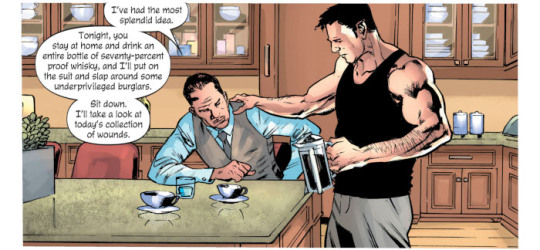
Battlepug #3 is more fun from Mike Norton, Allen Passalaqua, and Crank! Some really nice stuff here as Bryony cuts loose on Nobody’s Ponies. I absolutely love the mix of traditional sword and sorcery storytelling with rather over-the-top humour that basically lampoons it at the same time.
| Published by Image
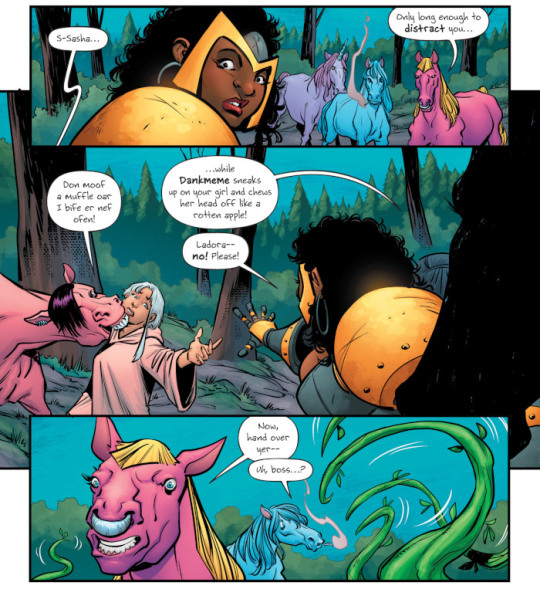
Black Cat Annual #1 is a fun tale of a heist on the Maggia by Black Cat and Spider-Man from Jed MacKay, Joey Vazquez, Natacha Bustos, Juan Gedeon, Brian Reber, and Ferran Delgado. It features the usual humour and action that we see in the series and I quite like how the artists are broken up each following one particular aspect of the story. Though it’s all one narrative, it gives a nice differing feel to each part.
| Published by Marvel

Black Hammer / Justice League: Hammer of Justice #5 concludes what has been an excellent series from Jeff Lemire, Michael Walsh, and Nate Piekos. Ultimately, this has reminded me of the old JLA/JSA crossovers of old, and just feels great as an overall story. Plus the possibility of seeing a sequel.
| Published by Dark Horse & DC Comics

Black Panther and the Agents of Wakanda #3 begins “God Loves, Moon Kills”, another two-parter for this series, from Jim Zub, Lan Medina, Craig Yeung, Marcio Menyz, Federico Blee, and Joe Sabino. I love this story format, giving us essentially quick-hit missions dealing with a problem and then moving on. It’s yielded some pretty tight storytelling and some fascinating situations.
| Published by Marvel
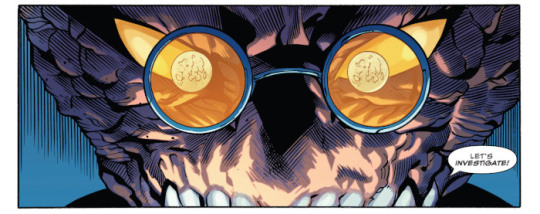
Black Stars Above #1 is another incredible debut for Vault, with Lonnie Nadler, Jenna Cha, Brad Simpson, and Hassan Otsmane-Elhaou delivering an incredibly deep and unique horror story. It centres around a young woman in a family of fur traders, as the trade itself begins to die in Canada, and it’s impressive as to how real the characters and their struggle feels. The artwork from Cha and Simpson is exquisite.
| Published by Vault

Buffy + Angel: Hellmouth #2 continues Buffy and Angel’s descent through hell. It’s much more cerebral than you’d expect, with the demons trying to get into Buffy and Angel’s respective heads in order to manipulate and destroy them. Plus, a rather interesting surprise. Jordie Bellaire, Jeremy Lambert, Eleonora Carlini, Cris Peter, and Ed Dukeshire are doing some great work with the core of this event.
| Published by BOOM! Studios

Collapser #5 somehow gets even stranger in this penultimate issue as Liam creates a “perfect” world to run away from the problems he’s having in the real world. The real world bleeding through and a revelation of his girlfriend’s true intentions just ratchet up the strangeness further. Mikey Way, Shaun Simon, Ilias Kyriazis, Cris Peter, and Simon Bowland are just doing amazing work here.
| Published by DC Comics / Young Animal

Detective Comics #1015 takes an interesting turn as Nora decides that she likes being a villain. Through this, Peter J. Tomasi is definitely showing an interesting side to Mr. Freeze, emphasizing again that he’s a rather conflicted villain, only doing the various heinous actions to save his wife. Who now doesn’t need him.
| Published by DC Comics

Doctor Mirage #4 features more incredibly beautiful, inventive artwork from Nick Robles and Jordie Bellaire. The visual storytelling as Shan faces the Embalmer is just incredible. Magdalene Visaggio, Robles, Bellaire, and Dave Sharpe continue to deliver magic with this penultimate issue.
| Published by Valiant
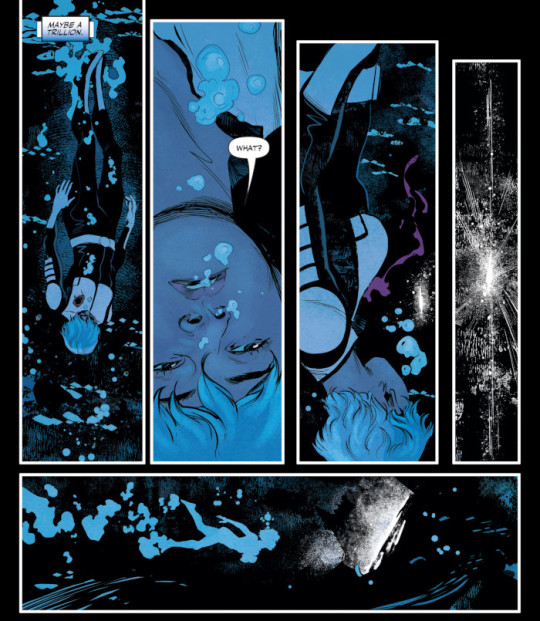
Edgar Allan Poe’s Snifter of Terror: Season Two #2 is another entertaining issue. The lead tale from Tom Peyer, Greg Scott, Lee Loughridge, and Rob Steen has traditional EC Comics horror vibes, as a scientist tries to communicate with our worm overlords. In one of the comics back-ups Mark Russell, Peter Snejbjerg, and Steen revisit the world of the breakfast cereal monsters. And there’s the usual prose pieces, poetry, and Hunt Emerson’s Black Cat.
| Published by Ahoy

Event Leviathan #6 concludes this series from Brian Michael Bendis, Alex Maleev, and Josh Reed. How much you enjoy it will hinge on how much you enjoy Maleev’s art and the realization that most of this tale is about moving one person off the board and the reveal of Leviathan to set up further stories. Also, Bendis paints a Batman who is ridiculously terrible at hiding his secret identity.
| Published by DC Comics
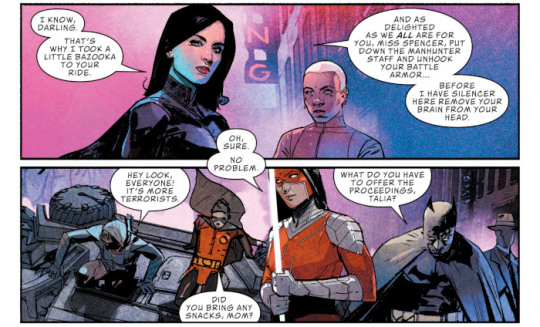
Fallen Angels #1 is the final new first issue of this first wave of “Dawn of X” titles and in many ways it’s more personal than the other X-titles, even Excalibur, delving into Psylocke (the former Kwannon, not Betsy Braddock) and her past. Bryan Hill, Szymon Kudranski, Frank D’Armata, and Joe Sabino deliver an interesting story with hooks on the darker side of the X-world, including some ominous bits from Magneto and Sinister, but I question the inclusion of X-23 and Cable. They don’t exactly seem to fit the roles they’ve been put into here.
| Published by Marvel

Family Tree #1 is a phenomenal debut from Jeff Lemire, Phil Hester, Eric Gapstur, Ryan Cody, and Steve Wands. This first issue perfectly captures that insidious nature of family drama mixed with creeping terror and body horror as a bizarre plague begins spreading across America.
| Published by Image

Far Sector #1 is one of the most impressive debuts I’ve read in a long time. NK Jemisin, Jamal Campbell, and Deron Bennett create a rich new world in the City Enduring and a compelling character in the new Green Lantern, Sojourner Mullein. The murder mystery that ties everything together is just the icing on the cake. Incredible world-building here and drop dead gorgeous artwork. Do not miss this.
| Published by DC Comics / Young Animal

The Flash #82 is part one of “Rogues’ Reign” from Joshua Williamson, Rafa Sandoval, Jordi Tarragona, Arif Prianto, and Steve Wands. It features a Central City taken over by the Rogues, transformed into their own personal playgrounds, as the Flash is nowhere to be found. It’s not bad, but the amount you’re going to like it may be relative to how much you’re also enjoying “City of Bane” and the recently concluded similar arc involving the Trickster.
| Published by DC Comics

Folklords #1 is off to a fantastic start from Matt Kindt, Matt Smith, Chris O’Halloran, and Jim Campbell. It starts off with a precocious kid in a fantasy world who’s been having visions of what essentially amounts to our world, whose quest sets out a rather draconian lockdown on their society when the Librarians rein in everyone from illicit action, like finding the Folklords. Highly recommended.
| Published by BOOM! Studios
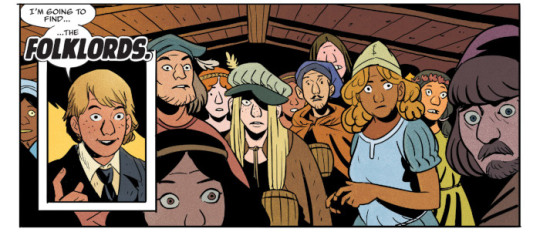
Forgotten Home #2 reveals more about Jannada, its history and society, and how an unjust queen was brought to rule through racial warfare. Love the artwork from Marika Cresta and Matt Emmons.
| Published by Vices Press

Gideon Falls #18 unleashes the Laughing Man on reality in part two of “The Pentoculus”. Jeff Lemire, Andrea Sorrentino, Dave Stewart, and Steve Wands are beautifully unfolding this twisted and horrific flower of a story.
| Published by Image
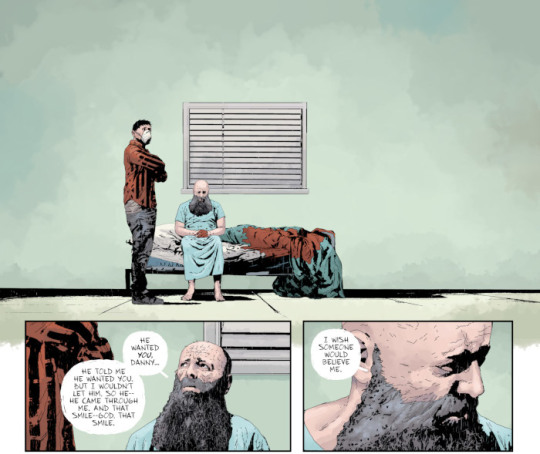
Gotham City Monsters #3 adds another element of DC lore to the series as Melmoth claims a particular prize. I really quite like how Steve Orlando, Amancay Nahuelpan, Trish Mulvihill, and Tom Napolitano are pulling together disparate bits of Gotham and beyond to craft this story.
| Published by DC Comics
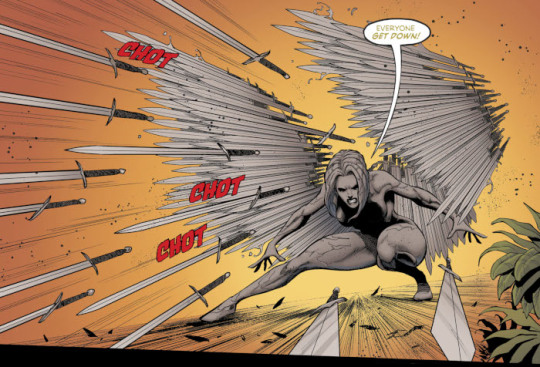
Guardians of the Galaxy #11 is the penultimate issue of this series from Donny Cate, Cory Smith, Victor Olazaba, David Curiel, and Cory Petit. It’s basically a big fight between the remaining Guardians and everyone else. It doesn’t go so well.
| Published by Marvel

Hawkman #18 takes a somewhat different approach to Hawkman’s infection than what we’ve seen of the others so far. Rather than being a dark reflection of Hawkman’s own desires, he’s taken over by an Earth-3 incarnation in Sky Tyrant. Robert Venditti, Pat Olliffe, Tom Palmer, Jeremiah Skipper, and Richard Starkings & Comicraft instead use that to play the spirit of our Hawkman against.
| Published by DC Comics

Hit-Girl: Season Two #10 is part two of “India”. The artwork from Alison Sampson and Tríona Farrell is impressive, given an amazing level of detail to bringing Mumbai to life. Brutal and rich in colour.
| Published by Image

House of Whispers #15 takes a new twist as the Corinthian finds the House of Watchers, takes over, and everything changes. Nalo Hopkinson, Dan Watters, Dominike “Dono” Stanton, Zac Atkinson, and AndWorld Design kick off some new terrors as even Erzulie’s status quo is upended, and we get another guest appearance of John Constantine’s homecoming.
| Published by DC Comics - Black Label / The Sandman Universe

Invaders #11 pushes deeper into Steve and Namor’s history and relationship, as Steve refuses to give up on his old friend. There’s some very heavy, very good character work here as we head into the final issue. Chip Zdarsky, Carlos Magno, Butch Guice, Alex Guimarães, and Travis Lanham continue to astonish at the incredibly high bar they’ve set for this story.
| Published by Marvel

Justice League Odyssey #15 is a fun tale from Dan Abnett, Will Conrad, Rain Beredo, Pete Pantazis, and AndWorld Design. Jessica Cruz leading a rag tag band of villains (and Orion) against Darkseid and the previous JLO turned evil is unfolding as a very entertaining story with some interesting twists. Also, Dex-Starr is awesome.
| Published by DC Comics
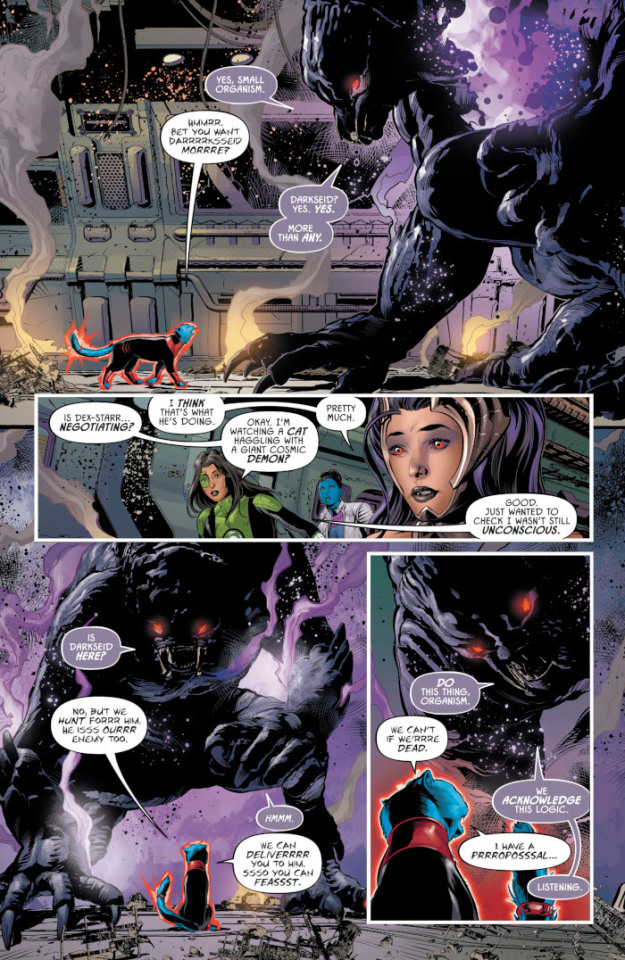
Morbius #1 isn’t a bad start from Vita Ayala, Marcelo Ferreira, Roberto Poggi, Dono Sánchez-Almara, and Clayton Cowles. This first issue is largely just action as Morbius sets out on his quest to cure himself, again, but it’s not bad. The art from Ferreira, Poggi, and Sánchez-Almara is very nice.
| Published by Marvel

Oblivion Song #21 continues the slowburn investigation and reconnaissance of the Faceless Men’s base, as Marco tries to map it out and discover where they’re holding all of the people who decided to stay in Oblivion. Gorgeous artwork from Lorenzo De Felici and Annalisa Leoni as we see more of the Faceless Men’s technology.
| Published by Image / Skybound

Psi-Lords #6 does a bit more world-building as we find out more about the Psi-Lords and the Starwatchers, even as the four Earthers are beset by the other Marked in a bizarre farce of a trial. Fred Van Lente, Renato Guedes, and Dave Sharpe are telling a pretty great sci-fi adventure tale here. It largely stands alone in the greater Valiant universe framework and deserves more attention than its getting.
| Published by Valiant

Punisher: Soviet #1 is another welcome return to the Punisher by Garth Ennis, stepping back into Frank’s adventures like he never left. Ennis, Jacen Burrows, Guillermo Ortego, Nolan Woodard, and Rob Steen deliver a brutal and bloody beginning as Frank chases down someone who everyone seems to think is him.
| Published by Marvel / MAX

Reaver #5 is a fairly impressive spotlight for Breaker as he does what he really didn’t want to do again in order to help his “friends”. Justin Jordan, Rebekah Isaacs, Alex Guimarães, and Clayton Cowles present a number of twists and surprises in one of the most brutal issues yet.
| Published by Image / Skybound
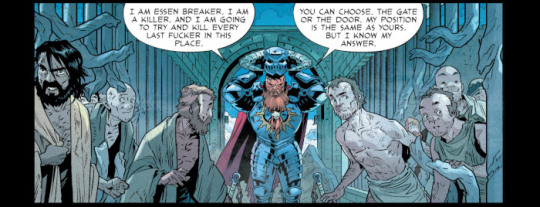
Ronin Island #8 sees the remaining islanders largely stand together as they try to both stand up to and flee from the Shogun’s soldiers and madness. With a terrible occurrence that looks like it’s going to cause even more problems for the survivors. Giannis Milonogiannis and Irma Kniivila’s art continues to be everything.
| Published by BOOM! Studios
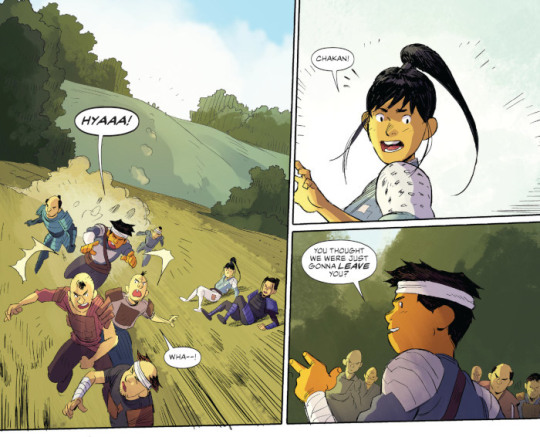
Sea of Stars #5 very nicely puts the pieces together as a disconsolate Gil has been captured and basically given up thinking Kadyn dead is brought to the world where his son is about to be gutted. Jason Aaron, Dennis Hallum, Stephen Green, Rico Renzi, and Jared K. Fletcher are telling an incredible story here and this issue throws even more twists at the reader.
| Published by Image

Seven Days #2 unfolds some of the fallout of people learning that they only have seven days left, as the superhero community is enlisted to try to stop whatever the shiny harbinger things are. Gail Simone, José Luís, Jonas Trinidade, Michelle Madsen, and Saida Temofonte are continuing to build an intriguing story here as we get more and more of the breadth of the Catalyst Prime universe.
| Published by Lion Forge / Catalyst Prime

Superman #17 is kind of a housekeeping issue from Brian Michael Bendis, Kevin Maguire, Paul Mounts, and Dave Sharpe, acting as a prologue to “The Truth”. A bit of reflection on the Unity Saga, Event Leviathan, and Year of the Villain.
| Published by DC Comics
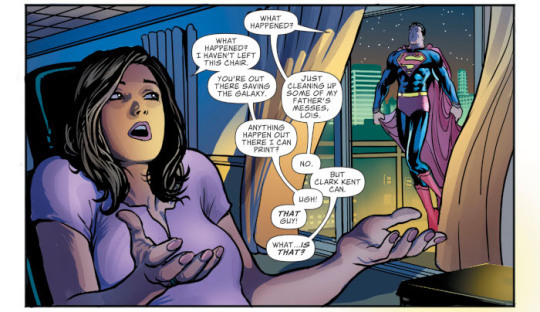
Tales from the Dark Multiverse: Blackest Night #1 might well be the best of these one-shots yet. Tim Seeley, Kyle Hotz, Dexter Vines, Walden Wong, Danny Miki, David Baron, Allen Passalaqua, and Tom Napolitano give us a bleak look at a world where Sinestro chose not to share the power of the White Lantern light and essentially everything fell to Nekron and the Black Lanterns. It’s a very unique take on the zombie apocalypse on its own, made more interesting as a fallen Sinestro, Lobo, and Dove try to save this universe. The art from Hotz, Vines, Wong, Miki, Baron, and Passalaqua is perfect.
| Published by DC Comics

Trees: Three Fates #3 continues to build up the weird atmosphere from last issue, then turns around and focuses on more of the gritty aspects of Oleg, Mik, and Nina. Gorgeous artwork all throughout from Jason Howard and Dee Cunniffe.
| Published by Image

Triage #3 shifts to Commander Marco’s reality as the group flee from the Hunter. I really like what Phillip Sevy and Frank Cvetkovic have been doing with this story. Great high concept, but the interpersonal relationships are where it’s really at.
| Published by Dark Horse

Usagi Yojimbo #6 is a beautiful updating and embellishment of the very first story of Usagi from Albedo by Stan Sakai and Tom Luth. This single issue story really captures the spirit and magic of all of Sakai’s stories, wonderfully portraying his mix of action and folklore.
| Published by IDW

Vampirella/Red Sonja #3 explores more of what the Russians were doing in regards to Drakulon and more. More very nice humour from Jordie Bellaire in the interactions between Vampirella and Sonja.
| Published by Dynamite
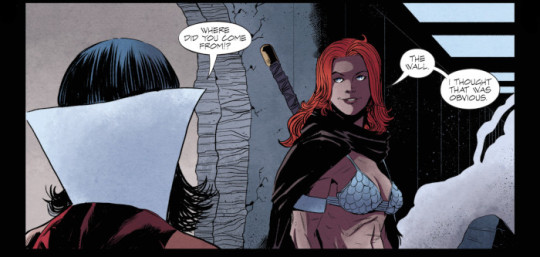
Wonder Woman #82 begins “The Wild Hunt” from the new creative team of Steve Orlando, Kieran McKeown, Scott Hanna, Romulo Fajardo Jr., and Pat Brosseau. It very much continues on from the plot threads and elements of the previous run, continuing to build on the current conflict between Wonder Woman and Cheetah.
| Published by DC Comics

X-Men #2 is pretty damn great, going back to the big and wild ideas bringing new elements into the X-universe, all while Cyclops gives some of the strangest parenting. Jonathan Hickman, Leinil Francis Yu, Garry Alanguilan, Sunny Gho, and Clayton Cowles give us a new mystery with the arrival of Arakko and the first of -|A|-’s missing original horsemen.
| Published by Marvel

Other Highlights: Age of Conan: Valeria #4, Agents of Atlas #4, Catwoman #17, Doctor Who: The Thirteenth Doctor Holiday Special #1, The Dollhouse Family #1, Elvira: Mistress of the Dark #10, Firefly: The Sting, Future Foundation #4, Ghosted in LA #5, GI Joe: A Real American Hero #268, Girl on Film, Go Go Power Rangers #25, Harley Quinn & Poison Ivy #3, History of the Marvel Universe #5, Marvel Action: Spider-Man #11, Midnight Vista #3, Moonshine #13, Runaways #27, RWBY (print) #2, RWBY (digital) #6, Savage Sword of Conan #11, Star Wars #74, Star Wars: Jedi - Fallen Order: Dark Temple #4, Star Wars: Target Vader #5, The Unbeatable Squirrel Girl #50
Recommended Collections: Babyteeth - Volume 3, Dark Red - Volume 1, Fallen World, GLOW - Volume 1: Versus the Star Primas, Justice League - Volume 4: The Sixth Dimension, Savage Avengers - Volume 1: City of Sickles, Star Wars: Age of Resistance - Heroes, Star Wars Adventures - Volume 7: Pomp and Circumstance, Wonder Twins - Volume 1: Activate

d. emerson eddy can hear the scratching at the walls of reality.
3 notes
·
View notes
Photo

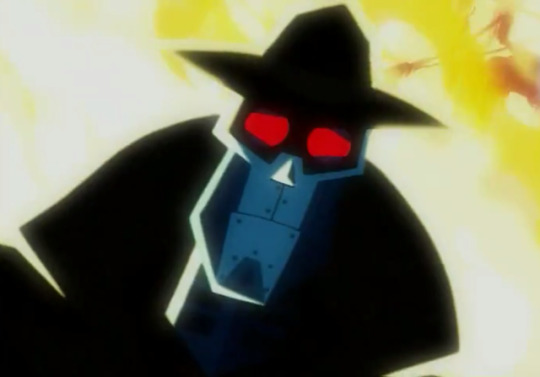
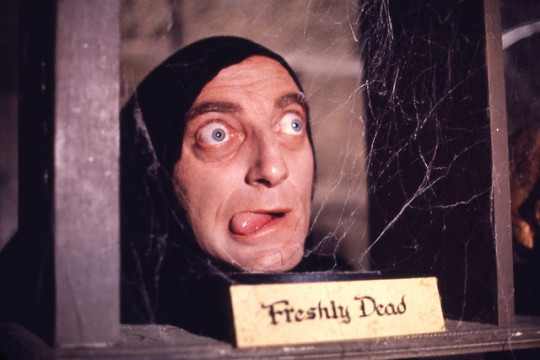

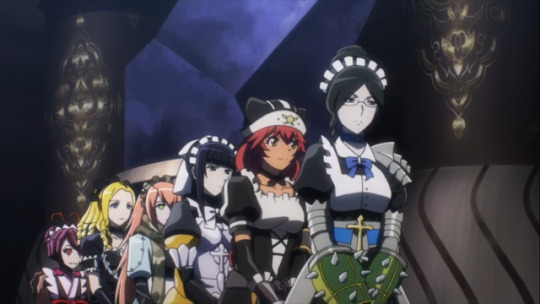

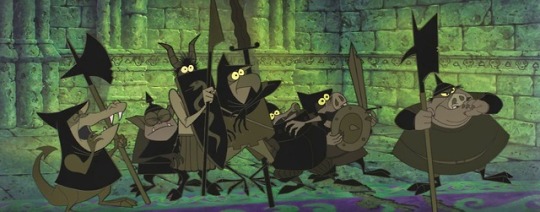
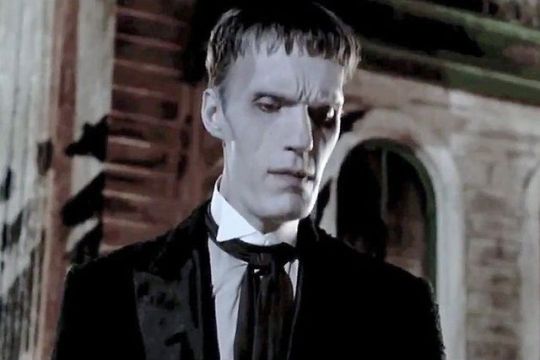


30 Day Monster Challenge 2 - Day #19: Favorite Minions/Henchmen
1. Minions (Overlord [Video Game])
There is only one creature we call ‘Minion’ in this house, and it is the Minions from Overlord. (The game, not the anime.) The Minions are the perfect… well, minions. They’re design is mostly goofy, but there’s also something kind of horrible to them; they’re like somebody threw an imp, a spider monkey, and a goblin in a sack and didn’t open it up again until the screaming stopped. Those buggy yellow eyes, the hunched backs, the crooked tails, the shrill voices; this is what pops into my head when I think of what an evil minion is supposed to be like. They are utterly and totally devout to their master; they have one purpose in life, and that is to serve you. They think absolutely nothing of throwing themselves into a forge just to upgrade your weapons or taking on a monster just because you tell them to.
Watching them swarm over a cyclops like a nest of army ants is always fun, but that hivemind mentality shouldn’t be mistaken for a lack of individual. The Minions are kind of precursors to the uruks from Shadow of Mordor; the longer they live and the more fights they survive, the more unique they become. They’re given names and titles, and they start gathering weapons and armor. It’s never made clear what exactly the Minions are in Overlord, but the implication isn’t that an Overlord chooses them; they choose the Overlord. Without the Minions, and Overlord is just some spooky adventurer in a suit of armor. The Minions make the man, and the fact that you need them as much as they need you is a pretty interesting power dynamic.
2. X-49 (Samurai Jack)
Just… do I really have to say anything? It was one of the best episodes in Samurai Jack, one of the best animated series of all time. And the music and the writing and the cinematography and oh god it’s all coming back at once

3. Igor (Young Frankenstein)
There never was an Igor in Mary Shelley’s Frankenstein; he’s a fabricated character at least partially concocted from Edgar Allan Poe’s Hop-Frog that somehow wormed himself into horror mythology. And honestly, thank goodness for that or we wouldn’t have had Marty Feldman’s fantastic performance for Young Frankenstein. Feldman looks like he was born for the role; his exophthalmos was a problem he dealt with his entire life, but Igor is just one example of how he incorporated his condition into his comedy personas. Igor is a good comedic counterpart to Gene Wilder’s Frankenstein in a classic double-act kind of way. Where Wilder’s Frankenstein is driven to escape his destiny or conform to it, Feldman’s Igor is committed to his role from the beginning, with no real perspective on it in the grand scheme of things. Igor undercuts Frankenstein’s deliberate melodrama to remind the audience that it’s all a joke.
4. Kobolds (Dungeons and Dragons)
Kobolds are one of the greatest success stories in tabletop roleplaying monsters. Kobolds have been in Dungeons and Dragons since the beginning, but they spent 1st and 2nd edition as basically another kind of goblin. Outside a few rare exceptions, kobolds were just an adventurer’s in-between step as they transitioned from clearing out rats in cellars to goblins in caves. For 3rd edition, the designers felt they needed to give kobolds something; a hook, a feature, a raison d’etre. So the design team though, “What if the littlest monsters had dreams about being the biggest? What if kobolds thought they were dragons?” The rest is history; kobolds became dragon minions, cultists who firmly believe that they are descended from the great wyrms they worship. Inside ever little kobold beats the heart of a mighty dragon, and their pluck and determination pushes them to reach for heights most humanoid races never even dream of. Kobolds are not only great examples of how to make a monster interesting from a game design perspective, but also of how endearing characters can be when you give them goals.
5. Pleiades (Overlord [Anime])
It always bothers me when evil overlords leave their castle staff of their minions list. A great villain should have their power displayed in everything around them, from their captains to their cooks. That’s why Ainz Ooal Gown’s Pleiades are so great; the castle maids for an evil fortress, each on is an individual fighter with her own superpowers. Following organization rules, each of the maids is also a monster; werewolves, shapeshifting oozes, a sentient swarm of insects, etc. And that’s the kind of creativity and attention to detail I love to see in an evil overlord’s forces. Look at where there isn’t a superpowered minion, and say, “No, this will not do. More evil.”
6. Hunchbacks (Castlevania)
I remember that my mind was blown when I finally realized the ‘fleamen’ from Castlevania were supposed to be hunchbacked Igors. While I was kind of disappointed that bizarre insect men hybrids, I am still happy that Castlevania didn’t neglect a favorite horror trope. Castlevania actually has a pretty unique staff; undead maids, zombie butchers, a plague doctor groundskeeper, and skeleton butlers. But it wasn’t until the Lords of Shadow games that the hunchbacks started being explored. One of the good things about Lords of Shadow was the implication that Castlevania itself is alive; the castle has always existed, and can’t even really be fully pulled through to our world. When the castle needs repairs, though, someone to repair it and expand it, it summons the hunchbacks out of nowhere. The hunchbacks are tied to the castle; they’re like cells in its body. They might know more about Castlevania itself than even Dracula, but they aren’t letting on. Their only job is to serve their master, whoever or whatever it might be.
7. Maleficent’s Goblins (Sleeping Beauty)
Maleficent’s goblins are little bundles of medieval monstrosity with enough character to be charming. They’re like the Minions, where I honestly can’t imagine them existing without a master. It wouldn’t surprise me if it turned out they were just demons conjured up by Maleficent from her firepit. The odds and ends of medieval armor and weaponry on top of their gargoyle aesthetic makes me think of very early Tolkien, like the first covers for The Hobbit and Return of the King. These little guys were the forerunners to orcs, uruk-hai, parademons, and every other evil monster army. Sometimes I still wish we could go back to minions like these.
8. Lurch (Addams Family)
The quintessential creepy butler. I feel like Lurch parallels Marty Feldman’s Igor in some pretty interesting ways. They’re both essentially half a joke, part of a comedy routine that requires someone else to land the punchline. The difference is that while Igor undermined Frankenstein to lighten the mood, Luch is deadly serious to contrast the Addams’ playfulness. Lurch wasn’t just a straight-man; he was a brick wall that you could throw anything off of. To be honest, I always kind of wondered what exactly Lurch was; I never really thought of him as human. My favorite theories are either that he was a flesh golem (since he was clearly based off Karloff’s Frankenstein), a homunculus grown for the family and passed down through generations, or just some really tall guy in a suit.
9. Dwergi (Van Helsing)
The Dwergi in Van Helsing have an unnecessarily cool design for what amounts to being Dracula’s grunts. The goggles, spines, and full leather outfits make me think of aliens or something that would be working for Clive Barker’s Cenobites. I can’t help but think of the ‘jawas’ that were through the gate in Phantasm. But I think that I love the Dwergi most as concepts for evil dwarves; ‘dwergi’ most likely derives from ‘dvergar’, a German word for dwarf. There are even evil dwarves in Dungeons and Dragons named duergar and derro. And that connections opens up so many possibilities for me. Imagine a dwarven sub-race mutated to be classical Igor characters, or adventurers encountering derro dressed all in mad scientist gear underground. The Dwergi have hidden depths when you know where to look.
10. Stormtroopers (Star Wars)
Out of the standard henchmen armies, Stormtroopers are still my favorite. Stormtroopers are up there with Red Shirts in terms of incompetence and mortality rates. Every now and then some random Stormtrooper manages to stand out and look like a badass, but even they usually have a lifespan of however long until the heroes arrive. I’ve heard some people argue that the humanizing elements of Stormtroopers, the way they talk about their day or are just trying to do a job, makes the very Nazi-coded Empire too sympathetic. But I would argue the opposite; the human aspects of the Stormtroopers make it clear how actually farcical the whole Empire is. The Stormtroopers aren’t some elite kill-force, they’re bumbling idiots. Whatever brutal efficiency they’re ascribed usually happens off-screen, and it quickly gets drowned out by the chorus of Wilhelm screams heard while trooper after trooper dies ridiculously. The Stormtroopers make it clear how fascism doesn’t raise the individual up but uses them as a disposable resource. The Stormtroopers as human characters make the Empire look inept, not empowered.
#30 Day Monster Challenge 2#30 Day Monster Challenge#overlord#samurai jack#star wars#addams family#dungeons and dragons#long post
46 notes
·
View notes
Text
Country Gravy
I have written an original work of fiction
----------------------------------------------------------------------------------
Sonny was driving. He had left San Francisco to be far away from the job that he no longer had. It was dark and he was upset because of the thing about his job that was mostly his fault. He thought about all the money and personal growth he would never have and felt sad. He was so sad that he did not see the deer crossing the road in front of him in Montana, which is where he was when this story began.
He was understandably confused, because there aren’t deer in San Francisco where he lived, and he didn’t know what to do about it. He went to hit the brakes, but his foot slammed on the gas instead for reasons that were beyond his comprehension.
Beyond his comprehension, perhaps, but not beyond the comprehension of Promise Spreckles, the deer in front of him with a computer-generated name that was using her psychic powers to compel Sonny into becoming the agent of her own self-destruction. Spiraling into a suicidal depression for reasons that would only be understandable to a hyper-intelligent deer-sorceress, she had used her psychic powers to make Sonny the agent of her own self-destruction, which I already told you about.
His smooth, nondescript South Asian good looks (Spreckles was generalizing because deer have no concept of race or geography) and above-average penis length he inherited from his mother did not sway Spreckles from her decision. In fact, she took no notice of such things, because she was a deer and her psychic powers did not apply to the vaguely ominous domain of foreshadowing.
Regardless, he mowed her down at 75 miles per hour. Did you know that Montana has several stretches of highway that have speed limits of 75 mph? You do now. That’s not actually relevant because he was in a 55 mph zone when it happened.
Preoccupied with thoughts of losing his boring software job for doing a thing that made rich people mad, he wasn’t able to react in time. Also the deer was controlling his mind.
“Oh no,” he cried out as he smashed into Spreckles, showering the empty highway with a splattering of deer viscera. He immediately pulled over and ran to what remained of the body. He cradled the deer’s head in his hands. “I really fucked you up,” he said. “Just like I fucked up my own life.” He reflected briefly on his relationship with his father. “That’s fucked up, too,” he said. He thought about all the times his father has been there for him except for the times his father abandoned him.
Sonny felt the deer’s head arteries spurt hot blood onto his jeans. They were $200 jeans because he was from San Francisco. He tried to comfort the deer, singing to it. He tried to sing Bob Dylan’s “Boots of Spanish Leather” but couldn’t remember the words or the tune. It ended up being “Twinkle Twinkle Little Star.” He thought the deer wouldn’t know the difference, but he was wrong.
The headlights of an oncoming car made Sonny look up. Braking hard to avoid the smear of cervine blood and guts spread across the pavement, the driver pulled over just before the car reached the red stain. Sonny watched as a man who looked like a portlier Josh Brolin from any Josh Brolin movie climbed out of his car.
“What in tarnation,” exclaimed the newcomer, who had an agriculturally adjacent profession and was allowed to talk like that.
But he had no idea how deep into tarnation he had stumbled.
Offended by the broken song and awakened by the raw sexual energy of two men who had nothing in common and no reason to interact with each other, Promise Spreckles called upon the forbidden energies that were ceded to her at the dawn of time when she had been formed from the primordial promise of spreckles. It looked a lot like that scene from Prometheus. You know the one.
The stranger took one look at Sonny cradling the severed deer head and got back into the car. At that moment, the deer pulled itself together, reconstituting itself in a brilliant flare of eldritch deer energy, reassembling itself organ by stomach-turning organ before their very eyes.
“Jesus Mary Joseph,” the stranger muttered before driving away. Sonny wondered what Josh Brolin was doing all the way out in Montana.
After the deer had pulled its body back together at a molecular level, Sonny stood up and got back in his car, continuing his drive to the cabin he had rented before this story was written. He had initially rented this cabin in the middle of nowhere, which was Montana, to get away from the crushing defeat of his own failure, but now all he could think of was a guy he had seen for maybe a minute and a half, tops.
Which was super great when that guy showed up at his door.
“Hey,” said Lawrence, which was that guy’s name. “I just thought I’d check in on that deer.”
“Oh,” said Sonny. “I think she’s fine.”
“That’s gravy,” said Lawrence. “Country gravy. Because I’m from the country. I live in a trailer. I poop outside.”
Sonny nodded. He was from San Francisco where they mostly pooped indoors.
“It’s just,” Lawrence continued. “I was kinda hoping I could have its skin, if it was still around.”
Sonny eyed him with an analytical gaze he had failed to apply to his job.
“I think the skin is still in use,” he said.
“Alright,” said Lawrence. Lawrence then left to do some things.
Sonny pondered this interaction, but not to the extent that Promise Spreckles did. She had exerted her psychic power to bring them together and yet they resisted. She thought back to what her friend Gambat had said:
“You can’t make two men fuck. Not until they are really awkward for a bit.”
She had questioned his wisdom then, asking why this should be.
“You see,” Gambat had replied, “men like to fuck, some of them each other. But if they do it right away, your story comes out to maybe two hundred words.”
His teachings had stuck with her, even years later, long after he had died of a strain of Bat Syphilis that only affects bats, which is what Gambat was.
And thus she had used her powers to bring Lawrence and Sonny together. She wormed her magic into Lawrence’s mind, leading him to Sonny’s cabin, showing him the lonely road where it could be found. For she had planted the seeds; a raw spot on her flank, red and bare, that burned with pain when she touched it. A necessary sacrifice for the greater work.
For Sonny had not seen, but Lawrence had. Oh, how he had seen. The scrap of fur and hide still clung to Sonny’s boot, and its bloody essence called to Lawrence. He had seen it from the doorway of the cabin and it would not leave his mind.
It was not long until he returned from the things he had been doing that were now done. Spreckles was waiting under the eaves of the house when she saw the lights of his approaching Land Rover Discovery and heard the rumble of its three-liter LR-TD6 diesel engine. Lurking under the window—which was completely unnecessary because she could read thoughts, but she was old school in this way—she heard Lawrence introduce himself once more.
“Hi,” he said. “I’m Lawrence.”
“I know,” said Sonny. “You look like an agricultural claims adjuster.”
“That is factually correct,” said Lawrence, who wanted to waste no time on small talk that was irrelevant to the larger narrative.
“I am indeed a claims adjuster,” he continued. “But more importantly, I am an amatuer skin enthusiast, and I can’t help but notice that bit of hide clinging to your boot.”
Sonny was nonplussed. “What, this?” he asked, pulling it from his boot and holding it to the light, missing the way Lawrence shifted his hips when he caught full sight of it.
Yes. Thought Spreckles. All is proceeding according to plan.
“Uh huh,” said Lawrence, breathing heavily. “That looks like the skin of a doe.”
“Wow,” said Sonny. “You really know your skin.”
Lawrence moved into the doorway. Sonny didn’t protest. He thought Lawrence smelled like Josh Brolin if Josh Brolin were dipped in butter, then dipped in butter a second time.
“Yessir,” Lawrence said, taking the scrap of hide from Sonny’s fingers.
“What are you going to do with it?” managed Sonny, if not a little seductively.
Lawrence recognized Sonny’s intent. “You know what they say,” he replied, fully aware no one knew what they said. “Females are for wearin’, males are for fuckin’.”
“That's not weird at all,” said Sonny. “I like normal not weird men that smell like my dad.”
Lawrence took off the hat he was wearing that was never previously mentioned. “It would be my greatest pleasure to fill the void your old man left in ya. Let me just change into my other skins . . .”
He was interrupted by Spreckles, who had determined it was time.
SUBMIT! she cried into their minds. She unfurled her penises.
YOUR SO CALLED AUTOMOTIVE “ACCIDENT” HAS BIFURCATED MY GENITALIA; YOU MAY BOTH NOW RECEIVE MY PENETRATIVE GLORY. ACCEPT MY SEED, MORTALS.
Spreckles was only somewhat surprised to find they offered no resistance.
“So,” Lawrence said to Sonny as he was penetrated by a transcendental deer phallus that glowed with psychic energy. “Tell me what went down with your last job, which I only know about because of the psychic penis inside of me.”
“I was fired,” Sonny ejaculated as Spreckle’s massive penis penetrated his entire body. “But the reason why doesn’t matter now because we only exist to pleasure our cervine overlord.”
“I agree,” said Lawrence, who thought this also.
VERY GOOD, thought Spreckles. I AM COMPLETE.
11 notes
·
View notes
Text
The Masque of the Red Death: Roger Corman Talks Pandemics and Restoration
https://ift.tt/3pjWssJ
During the 2020 lockdowns and ongoing COVID-19 pandemic, people at home sought isolated comfort. News reports continued to count the number of dead while people in charge downplayed its seriousness or offered dubious advice on dealing with the disease. It certainly didn’t interrupt many golf games. As workers were furloughed from jobs, they binged. One of the movies at the top of the playlist was The Masque of the Red Death, Roger Corman’s 1964 low budget masterpiece.
It told the tale of a wealthy medieval prince in a country decimated by an epidemic. The satanic overlord, played by the legendary actor and horror icon Vincent Price, locks his gates to his god-fearing dominions while he and his friends party like it’s 1999.
Edgar Allan Poe’s “The Masque of the Red Death” is about 2,300 words. Corman’s adaptation, which has been fully restored and can now be seen in its lush, psychedelic splendor, padded it with more Poe to reach 90 minutes. The screenplay by Charles Beaumont and R. Wright merged the tale with Poe’s “Hop Frog,” along with elements of the short story “Torture by Hope” by Auguste Villiers de l’Isle-Adam.
The devilish revelries came deep into a filmmaking cycle that began with American International Pictures executives Samuel Z. Arkoff and James Nicholson asking their in-house director Roger Corman to make two black-and-white horror films at $100,000 each. At the time, Corman had been producing tightly budgeted horror, science fiction, and juvenile delinquency quickies. With this opportunity, he pitched one film based upon Edgar Allan Poe’s “The Fall of the House of Usher,” saying it would move AIP to up in the motion picture world, as the studio was regarded as the maker of exploitation pictures.
It was the first of a cycle of eight films. Poe is read in every high school and is part of America’s literary canon; Corman’s Poe cycle made the writer an international gothic horror fan favorite.
The Masque of The Red Death was the seventh in Corman’s series. The adaptation also stars Jane Asher (Alfie, Death At A Funeral), Hazel Court (The Premature Burial, The Raven), David Weston (Becket, The Red Baron), and Nigel Green (Jason And The Argonauts, Zulu).
The 4K restoration of the extended cut of The Masque Of The Red Death was done by Martin Scorsese’s Film Foundation, and the Academy of Motion Picture Arts and Sciences. Additional funding came from the Hobson/Lucas Family Foundation. The Masque of the Red Death opened the same year as Stanley Kubrick’s nuclear nightmare Dr. Strangelove or: How I Learned to Stop Worrying and Love the Bomb. The fallout from an atomic war would result in a Red Death among survivors. Corman’s take on Poe was seen as a comment on the collateral damage of the Cold War, but it is a film which bridges generations of apocalyptic omens.
We spoke with Corman about the timeliness of his classic adaptation, as well as about stars Price and Asher, cinematographer Nicholas Roeg, and why Corman continues to find different delivery systems for message pictures.
Den of Geek: The last time we spoke, it was right before the inauguration. You had put Malcolm McDowell in funny hair and made him the president of the United Corporations of America. At the time, you said you hadn’t expected Trump to win. Today is the day after his (second) impeachment. Now that 2020 turned out to be a death race, did you expect him to be President Prospero?
Roger Corman: No. I assumed that [Joe] Biden was going to win. The polls all indicated that he was ahead. The polls have not always been correct, but in this case, they were so much in his favor, I assumed he was going to win.
Was there a conscious effort to put out The Masque of Red Death during the COVID-19 crisis with him as president?
Yes. Masque of the Red Death, in the United States, was on one of the platform streaming services, and the ratings on it went way up during COVID, because it was so appropriate. It’s actually more pertinent today than when it was made, because we do have the equivalent of the Red Death pandemic that is killing people all over the world.
In Masque of the Red Death, Prince Prospero brings together his friends, aristocrats and so forth, and they hold themselves up in the castle, to prevent the Red Death from killing them. And we have a somewhat similar situation today.
For instance, Trump is very careful. He claimed that the coronavirus was overrated. As a matter of fact, he said there was no such thing as coronavirus; it was “a hoax” perpetrated by the Democrats to make him look bad. But at the same time he was saying that, he was holed up in the lighthouse, going up primarily only to play golf or to hold big rallies. People were not protected within the rallies, but he himself made a real point of staying away from the crowd, to be on the stage and let the crowd get together and kill themselves, which they did.
The Mar-a-Lago of Red Death.
The Masque of the Mar-a-Lago.
Is it hard to keep a social distance when you’re squirming around on a floor like a worm?
It’s a little difficult, I would believe.
Vincent Price’s voice is beautiful in this movie. This is one of his most seductive parts. How quickly did he capture the character, from rehearsal to shooting?
He had the character pretty much set in mind when he came into it. Vincent always did a great deal of preparation. So what we would do [is] we would discuss the characters, just Vincent and me, before the rehearsals. He and I were in agreement on the character, and then he would bring that character to the rehearsals. We did not do a great deal of rehearsing because of the Screen Actors Guild rules. They charge you as if you are shooting when you rehearse.
Do you remember any notes you had to give him?
This is so long ago. It’s a little bit difficult to remember. But as I remember, I said, “The real key to Prospero’s character is that he believes God is dead.” And everything stems from that belief. That with the absence of God, he was free to do anything he wanted.
Did he always talk like that, like when he was ordering a bagel?
It was pretty much his normal voice. He added a certain drama to [lines], but basically that was Vincent. He was a highly educated man and very intelligent, so he spoke very well. And we simply heightened that somewhat in the films.
The film suffered some major censorship from the Legion of Decency, and the package booklet points out there was church involvement. Did you ever wonder whether you might be going to hell?
No, that never occurred to me. I’m sort of a lapsed Catholic, and I don’t believe there is a hell.
Is Red Death a disease or a sin?
The Red Death is a disease. That’s one of the reasons that’s a plague. You could consider it to be the Black Death of the Middle Ages. It would be the equivalent of coronavirus today.
In the booklet which comes with the DVD, it says that Father Miraliotta said the occult parts of the screenplay were “strung together gibberish” and “mumbo-jumbo Latin.” But did any of the satanic rituals have any validity?
No. We made up pretty much what we wanted. Actually, there were two writers, Chuck Beaumont and Bob Campbell, and I think it started with my discussions with Chuck.
How was Jane Asher to work with?
Jane Asher was wonderful to work with. She was a very young girl. She had worked on the stage. I think she was in the Young Shakespeare Group. And I don’t know if it was her first picture or not, but she was very good. She was an excellent actress and very good and easy to work with.
She was dating Paul McCartney when this was made, and her brother was a musician and a producer. Did you get to experience any Swinging London in-crowd during shooting?
A little bit. As a matter of fact, I can tell you a true story. Jane and I used to have lunch together in the studio commissary. And on a Thursday, she said a friend of hers was traveling through, on his way to London the next day. Would it be all right if he came and watched a shooting during the morning, and we could all have lunch together? And I said, “Sure, fine.”
Read more
Culture
When Paul McCartney Braved the Set of Roger Corman’s The Masque of the Red Death
By Tony Sokol
So, I got a director’s chair, sitting next to mine, during the shooting. And it was a nice, young guy, and we talked during the shooting. And I explained to him a little bit between shots how it all worked. And then we all, Jane and he, and I, had lunch together. And it all went very well. I said at the end of it, “Jane tells me you’re going to London. What are you going to be doing in London?”
He said, “Well, I’m with a singing group from Liverpool, and we’re going to be making our debut tomorrow night in London.” He was very cool. He knew that as an American, I didn’t know who The Beatles were or what he was. And as he left, I said, “Well, good luck, Paul, on your debut in London tomorrow night.”
And I remember he was very cool. He understood and he didn’t want to say, “Listen, buddy, we’re the number one group.” He just said, “Well, we’re a singing group.”
And then I saw the paper Sunday morning headlines, “Beatles conquer London.”
Did he ever come back to the set again?
No. But it was very funny. We were at an Academy Award party, which was I think the Vanity Fair party, which was a big thing, of people who were invited and so forth. We were at the Vanity Fair party, and I saw across the room Paul McCartney. And I said, “Oh, there’s Paul over there.”
And my wife, Julie, said, “Let’s go over and talk to him.” And I said, “No. I had lunch with him 60 years or so ago. He isn’t going to remember some guy he had lunch with 60 years ago, and I don’t want to intrude.” because he was in a conversation.
And Julie said, “Well, I want to meet Paul McCartney.” So, she went over and talked to him, and he came over to see me. As he approached, he said, “Masque of the Red Death.” He knew exactly where we’d met.
I interviewed William Shatner a few months ago and I asked about The Intruder, a piece he’s still very proud of. What draws you to consistently infuse your works, in any genre, with at least social questioning?
I’ve always been on the left, liberal side of politics. The Intruder was a time when the desegregation of schools in the South started. The schools in the South had maintained separate schools for Blacks. They were separate, but equal. And the Supreme Court ruled they were separate, but they were not equal, which was correct. They were inferior, and schools had to be integrated rather than keeping them separate. And it caused tremendous rebellion in the South. Chuck Beaumont, who worked with me on a number of pictures, had written the book The Intruder about an agitator, a little bit like somewhere between Joe McCarthy and Trump, who comes in, talking about patriotism and being against integration.
And I bought that book, The Intruder, and made it with Bill Shatner. It was his first picture. He was a Broadway actor, and he just came to Hollywood, and he was wonderful to work with, and the picture got incredible reviews. I’m trying to think of one of them, which was really good. Oh, it said, “The Intruder is a major credit to the entire American film industry.” And it won a couple of awards at minor festivals nobody ever heard of, but it was the first picture I ever made that lost money.
You consistently do social commentary in your work. What brings you back to it?
I stayed with it, but I tried to analyze why The Intruder got such wonderful reviews and such a great reaction, but the audience didn’t come to see it. And I thought, “I think I was too serious in this.” It was almost like delivering a message. And I remember years ago, some Hollywood producer said, “If you want to send a message, use Western Union.” And I thought, “I broke that rule.” And I thought, “I forgot that motion pictures are really basically an entertainment.”
So, from there on in, I used motion pictures as an entertainment, but as a subtext, with whatever theme or thought I was interested in. But first and foremost, the audience came to see and got the entertainment they paid to see. And as a bonus, as it were, there was the subtext, which sometimes was so slender that people didn’t get it. But [some] people got it. That was fine with me.
The restoration is really beautiful. I’d like to ask about the look. Your translation of Poe’s colors. Nicolas Roeg was the cinematographer. What was that collaboration like?
It went very well. It was the first I had done in England, except for a Formula One racing picture, which was in England and a number of other places. And they showed me a work of a number of English cameramen, and I thought Nic was the best of the group. And the collaboration went very well. I thought he did really, a brilliant job of camera work.
Afterwards he became a director. I never knew, did I inspire him to be a director, or did he feel if Roger can do it, anybody can do it?
So, he didn’t actually go through the Corman school of directors. I know you never produced any of his films.
I did not. He did it on his own.
You shot Masque on the set of Becket. What was different about having that as a cinematic playground, as opposed to shooting Saint Valentine’s Day Massacre?
It wasn’t really the set of Becket. What it is, Danny Heller, my art director, and I, always went to what was called a scene dock in studios where we’re going to work. The scene dock contained flats from previous pictures, just individual flats. Each of the pictures we shot in the United States, we were shooting at small rental studios, and the flats were not particularly impressive, but Danny would use them in the designs of sets.
When we did Masque of the Red Death, we found these magnificent flats from Becket. So they were not the sets, but we used those flats, and used them as an integral part of the sets.
Masque of Red Death was one of the first films that you had a longer shooting schedule. What was the first aspect of filmmaking that you noticed was affected by the extra time?
Well, two things. The English crews were very good. They were fully equal to the Hollywood crews, but they worked a little bit slower than the Hollywood crews. So I had a five-week schedule, whereas I had a three-week schedule in Hollywood. And I always thought I really had a four-week schedule, because we were working a little slowly.
Also, when we’d show up to work at 11:00, we would stop for elevenses. And then we would stop for lunch. And then in the middle of the afternoon, we would stop for tea. And I remember mentioning, I’ve forgotten who the assistant director was, but I said, “We’re spending half the day eating here. We should be shooting.”
But he said, “Well, this is the way we do it.”
In 2009, you made the Joe Dante series, Splatter, and each episode was shot in a week based on audience votes. Was that reminiscent of your early days of shooting on the 10-day schedules?
No. By that time, when I first started, although I did shoot a number of films in five or six days, in one picture, The Little Shop of Horrors, in two days. But my general schedule was two weeks when we started. As we moved along, starting with The Fall of the House of Usher, the first of the Poe pictures, I had three-week schedules. And our standard schedule for everything at that time was three weeks, so it was shot on a three-week schedule.
Did you really edit Little Shop of Horrors during a lunch break?
No. I shot Little Shop of Horrors in two days with a little bit of night shooting. So I’d say maybe two-and-a-half days. What happened, I had an office at a small rental studio in Hollywood and I was having lunch with the head of the studio. And he mentioned they had just finished a fairly big, slightly bigger budget picture. It was still low budget, and they had this really good, big set of an office. And I said, “Can you leave that up for a little while?” And he said, “Sure. We’ll leave it up until somebody comes in and rents the stage. And we’ll tear it down and put up the new set.”
So, after lunch, I went over and looked at it. And it was really a very good set, and I said [that] I was sort of experimenting with the concept of comedy and horror combined. And I thought, “It might be fun.”
I didn’t have a great deal of money at that time and nobody was going to back me with what I wanted to do. I thought, “I could shoot a picture here. And since almost everything is within this set, what I could do, I could shoot it in a couple of days, based upon this.”
Read more
Movies
Little Shop Of Horrors & the Tale of its Lost Ending
By Seb Patrick
Movies
The Roger Corman Fantastic Four Movie: The Most Faithful FF Ever
By Mike Cecchini
Screen Actors Guild salary structure was such that if you hired a person for a day, he got more money than one-fifth of what the weekly structure was. So I thought what I’ll do is hire everybody for a week. We’ll rehearse Monday, Tuesday, and Wednesday, because everything is in this set. And with everything set up, we can come and shoot on two days, on Thursday and Friday, which is what we did. And the whole thing was done sort of as an experimental lark.
It was quite successful. They made a Broadway play out of it and one thing and another, and a musical. And one of the reasons I think it was so successful was that none of us were taking it seriously. We were taking it and just sort of fooling around and having fun. And I think that attitude helped the picture, because the crew had the same attitude, and the whole thing permeated the shooting.
I remember we started shooting Thursday morning at 8:00. And at 8:30, the assistant director announced we were hopelessly behind schedule.
What are your favorite genres to shoot, and are they the same ones as the ones you watch?
Not particularly. I should watch more genre films to keep up with it. Actually, I watch a certain number, specifically to keep up and see what’s going on now. But I’m more inclined towards somewhat more serious films, and particularly foreign films, although I see fewer foreign films now than I did before. I don’t know why.
We were a production/distribution company, New World, which I founded in 1970, and we distributed for Fellini, Bergman, Kurosawa, Volker Schlöndorff, François Truffaut, a number of others. And I was a great fan of those films and went out of my way to distribute them. I was very much interested in that type of film.
In your early films, were you watching Mario Bava to see what he was doing? And were you expanding on that?
Actually, I saw only one film by Mario Bava, who incidentally I think was a brilliant filmmaker. It was because Jim Nicholson, who was the head of American International, had seen the film and liked Barbara Steele in it. He suggested I see the film and possibly use Barbara Steele.
I saw that one film. I don’t remember the name of it, but I thought it was really excellent. And indeed, I did bring Barbara Steele over. I think it was The Pit and the Pendulum. She played the leading lady.
What did Poe bring to your storytelling that, say, Lovecraft’s adaptations didn’t provide?
Well Poe, and this was part of my interpretation of Poe, I think Poe was working with the unconscious mind, from a writer’s standpoint, the same way that Freud, a little later in the same century, was working from a medical standpoint. I think the concept of the unconscious mind was starting to influence thinking in the 19th century, so I always thought that Poe represented the unconscious mind, and I shot according to that. It was one of my themes.
For instance, I felt the unconscious mind doesn’t really see the world. The conscious mind sees the world with eyes, ears, and so forth, and simply transmits information. So I made a point on all of the Poe films of never going outside unless I absolutely had to do it. I wanted to have full control, to shoot within the studio. Whether it came through to the audience, I don’t know. But at least in my own mind, I was able to deal with special effects with a number of things, with the concept of the unconscious mind.
When I did go outside, I tried to make it something that was not normal. For instance, on the very first picture, The Fall of the House of Usher, the only exterior sequence is when a man, played by Mark Damon, rides through a forest on his way to the House of Usher. And before we were shooting, there was a forest fire in the Hollywood Hills. I saw a picture of it in the Los Angeles Times, and all of the trees were burned. Everything was covered with ash, and I immediately put together, I think, a three or four-man crew. And we were up there in the Hollywood, burnt out hills, showing Mark on his horse, riding through that exterior.
I also used the ocean, a number of times. I feel that essentially, we came out of the ocean, and I felt somehow there is something fascinating about the ocean, even today.
Hazel Court’s invocation sequence is exquisite. When you were putting it together, were you having fun experimenting, trying to capture the unconscious mind?
Yes, it was all of the above. It dealt with the unconscious. We were experimenting, and I was having a lot of fun. I give a lot of credit to Danny Heller, the art director on that, because he would construct certain backgrounds. I would then work with different colored lenses on the camera, and then we would go in to a special effects shop, and they would take what I’d shot and overlay certain images. It was just a lot of fun putting them together, but I think I used that concept in almost every one of the Poe films.
And then of course, many, many years later, when I did The Trip, which was about an LSD experience, I really went crazy with those sequences.
On the other hand, I have to say this, at the time they came out, I got a lot of critical praise for that. But if you look at them today, they look primitive because the special effects today are so brilliant and so far advanced, that not only my pictures, but everybody was pictures at that time, when we used special effects, there was no way we could get the effects you can get today.
What do you think we’ve lost from the Mitchell cameras and having to lug things around and meticulously put together special effects? What do you think is lost in technology making filmmaking easier?
What’s gained is the fact that the special effects are just beyond anything anybody ever dreamed of before. They’re just astonishing. What is lost is the fact that there’s a tendency for the special effects to take over the picture, and the story and the characters are secondary to the special effects. And we’ve lost that to a certain extent. I wouldn’t say all the way, but we’ve lost to a certain extent the examination of characterization and the simple narrative, and the writing of dialogue.
How do you work with your composers on your films?
I work with composers probably a little less than most directors do. I don’t pretend to have great knowledge of music. What I do [is] I talk with the composer and discuss the themes, the mood within each individual scene, the basic feeling I want from the music, and then I leave it to him.
For instance, directors are generally on the soundstage when they’re recording the music. I’m never there. I’m not a conductor. I leave that to the composer.
The last movie you directed was Frankenstein Unbound in 1990. What would it actually take to put you back in the director’s seat?
Well, what happened was because when I started in 1970, I started my own production/distribution company. And I had planned simply to take a year off from directing, because I was just tired. I’d directed about 60 films in about maybe 15, 16 years. And I thought I would take a sabbatical, one year off from directing, and just be a producer and a head of the company. But then the company became instantaneously successful.
It was really amazing. Our very first picture was a giant success, and so were all of the following ones. And I got so involved in all of that [that] I just stepped away from directing. But then Universal did some kind of research, and they came up with the idea that “Roger Corman’s Frankenstein” would be a success for a film, and they asked me if I would like to make it, to produce and direct it. And I said, “No. You may have that research, but in my opinion, it’s just going to be another Frankenstein film. There have been so many Frankenstein films. It isn’t worth going back.”
But they kept coming back to me, and they offered me so much money. Finally, I thought, “Geez, I’d be an idiot not to turn this opportunity down for what they’re now offering me.” And I said, “All right, I can’t say yes right now. But if I can find a new version, something that is a different interpretation of Frankenstein, I will do it.”
And I read a novel, Frankenstein Unbound, by Brian Aldiss, a very good English science fiction and fantasy writer. And it was a story of somebody from the future, who, through a time warp, is thrown back into the 19th century and meets Dr. Frankenstein.
In the novel, he was some sort of a diplomat. But in the movie, I changed him from being a diplomat to a scientist, so that the picture essentially brought a 21st century scientist back to meet a 19th century scientist. And I thought that was an original and new interpretation. So I said, “If you can buy that novel, I’ll make the picture.” Which we did.
With all the streaming alternatives now for new projects, do you think it’s easier for an independent director to break in, or is it still just the same corporate-owned studio stuff?
I think you would divide that into two sections. It’s a little bit more difficult today, particularly with the studios, because they’re making now primarily these giant special effects pictures, and they’re not going to give a new director a chance to play with a $200 million budget.
But new directors are breaking in pretty much the way they were when I started, which is on independent films and particularly on low budget films.
You’re both the producer and the director on Masque. Were there things that you wanted to do as a director that you wouldn’t let yourself do as a producer?
I was a producer and director on almost all of my films, so I never really had any problems with the producer. If there was a problem with the producer, it was a problem with myself.
cnx.cmd.push(function() { cnx({ playerId: "106e33c0-3911-473c-b599-b1426db57530", }).render("0270c398a82f44f49c23c16122516796"); });
The Masque of the Red Death is available on Blu-ray, DVD, and Digital now.
The post The Masque of the Red Death: Roger Corman Talks Pandemics and Restoration appeared first on Den of Geek.
from Den of Geek https://ift.tt/2Mnk6X1
0 notes
Text
Day 4 - The Wonders of Maguey
We packed up, but before we left, we interviewed Lucia, the owner of the home’s mother about La Malinche and her role in the conquest. She took the view that La Malinche had no choices. She was a slave betrayed three times, once by the Aztec rulers that most likely murdered her father for not bending the knee, once by her own people by being sold into slavery to the Chontal Mayans, and once more by the Mayans after their defeat against the Spanish when she and 19 other young women were given away as gifts to the invaders. She wishes the people of Mexico would empathize more with La Malinche as a human being and believes that sexism and Mexico’s traditionally machista culture is partially to blame for La Malinche’s legacy being cast in such a negative light, or simply not talked about at all.
Before leaving town we got some great breakfast

then stopped at the Regional Anthropological Museum which boasts the largest collection of Mesoamerican artifacts








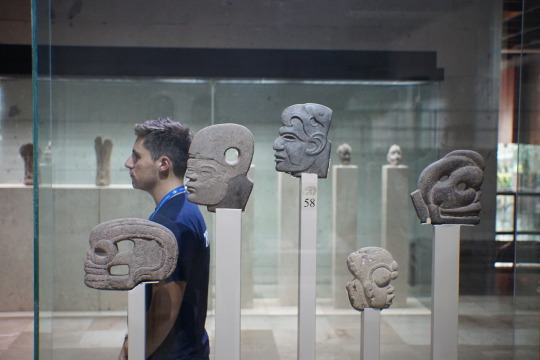



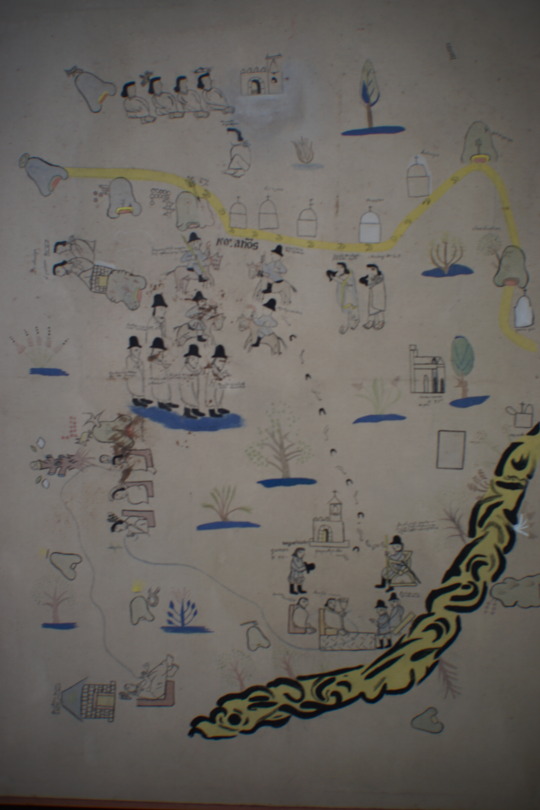











On our way out we bought some reading and visual resources to use back in our classroom with the kids!

As we drove away from Xalapa and towards Tlaxcala, we entered a mountain range where the lush green of the southeast was replaced by a more rocky and arid landscape. Strange desert trees dotted the craggy hills, giving the landscape an alien quality.


Up ahead, the volcano named La Malinche loomed nearer, and we saw signs inviting hikers to its daunting peak.

We arrived in Xalapa and put down our bags for our next overnight stay - a gorgeous country home that looked like it came from the 1500′s.



I asked the woman who handed over the keys about the city’s legacy in regards to the conquest. She paused. I asked her if Tlaxcala’s role in aiding the Spanish to overthrow the Aztec had some kind of significance to the people who live here. She took issue with my suggestion that the Tlaxcalans helped the Spanish, sharply replying “in a way” to this suggestion and ignoring the rest of the question.
Her response was intriguing. It was almost as if the suggestion that the Tlaxcalans helped the Spanish was offensive. It’s true of course. Cortes’ force numbered 500 at most. He made a peace offering with the powerful and militant city-state of Tlaxcala since the Aztec were their sworn enemies, and 3,000 Tlaxcalan warriors followed them into battle. So did my question seem to imply that her town had a history of treason? Who did they betray? The Aztec overlords who ruled through military dominance and fear? There’s a discomfort when talking about the conquest for many Mexicans, myself included. Whom do we identify with? We are a product of mestisaje (Native and Spanish), after all: children of the conquest for better or worse. We are a mixed people. Our culture is a melting pot of Spanish and Indigenous tradition. While the trauma of colonialism is still strong, many people reject colonialism and the Spanish conquest in the historical sense, pining for the ancient days of Aztec rule, but in their daily lives, Eurocentrism and whiteness is worshipped and indigenous voices and influences are cast aside.
This is a tangle of thorns nobody is equipped to unravel, so I won’t pretend to try, but it is interesting where this aspect intersects with our investigation of La Malinche.
Anyways... the house was amazing and we played a lot of ping pong, blasted Mariachi ballads and sang along at the top of our lungs

Then we head out into the center of town where the municipal palace wowed us with the most impressive mural I’ve ever seen. The mural showed snippets of the region’s history, from the first people cultivating the precursor to corn, Tlaxcala’s rocky history with the Aztecs, their eventual alliance and peace with the Spanish (as brokered by La Malinche) all the way to independence and the revolution.

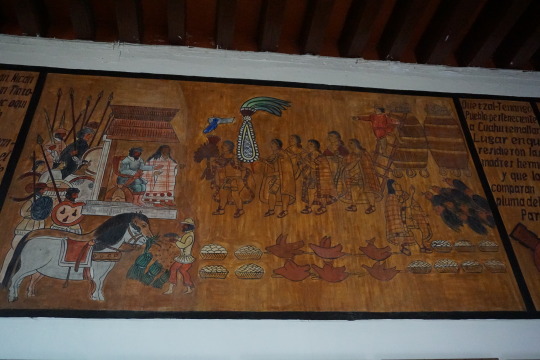
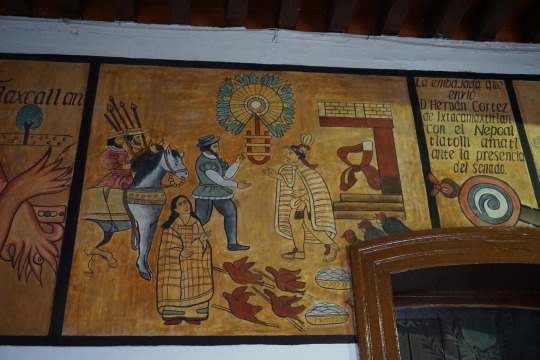






Tlaxcala is a unique place for a very significant reason. Since they were the most essential allies to the Spanish in taking down the Aztec empire, they were allowed to keep their sovereignty and its rulers were awarded the status of nobility. This meant more independence for the Tlaxcalans and more privileges than other native peoples. I thought that perhaps this would mean the locals would feel pride at this, but again, the muddiness of conquest politics makes in difficult.
After soaking in the mural and taking many pictures to use as visual sources in the classroom, we visited a pulqueria. Here we sampled some pulque, an alcoholic drink that goes back thousands of years made from fermented agave pulp. It had a slimy viscosity that puts many off, but I enjoyed it overall. To accompany it, we had some bugs that like to call the plant home: escamoles (ant larvae and pupae made with butter, minty herbs, and chiles), and fried maguey worms that were served with grilled panela cheese, guacamole, green and red salsas, and fresh corn tortillas. Roberto and I made quick work of these pricey delicacies. Glen and Greg had some, were satisfied, and were gracious enough to let us eat the rest.




We ended the night at a mezcaleria in a winding alleyway where we sampled some of their wares. Mezcal is a popular drink in the south made by wrapping and smoking maguey pulp, often with fruits, herbs, or nuts, then letting it ferment. It has a smokey flavor that pairs well with worm salt (exactly what you think it is) and orange slices.


HARDSTYLE

We drove back to the country home and were startled when the groundkeeper suddenly appeared in the doorway when he heard us come in, asking if all was well. Greg was convinced it was the start of a slasher flick, but we woke up with all our blood and limbs.
It’s a good thing too, because before we went to bed we challenged ourselves to climb to the top of La Malinche volcano early in the morning.

6 notes
·
View notes
Text
Cardfight Vanguard
Hello again it's mike back with another worm hole story. This time my hair braided idea lands me in the Cardfight Vanguard world. Enjoy
World hopping had been very interesting. After landing in a alleyway I had to find out where I was. Walking out onto the sidewalk I was ran into by a little brunette girl,"Oof" I'm sorry I said to the child. "It's ok I wasn't watching where I was going" she replied. "What town is this by the way ?" I asked, she gave me a confused look and said " your not from around here are you?" no I'm not. I woke up in an ally with no memory of how I got their and I had these decks in my bag and I don't know how these got here." Giving a flustered look. The girl give me a sympathetic look then looked like she had an idea. Grabbing my hand she pulled me along with her saying that she knew someone who could help. So I followed her to what looked like a card shop called " Card Capital". She led me in and I saw people who look like I had seen them before but I didn't know where. A man with spiky brown hair and glasses was behind the counter. "Welcome back Emi" he said with a smile, then Emi asked if her brother was here and he pointed to a table where a game was being played. Emi then walked outside and told me to come on in. Now I'm not a small guy i towered over the man behind the desk ( I'm the same hight as Tetsu) . Being lead in by Emi she introduced me explaining my case and the different decks in my bag. I showed him the decks. Kagero, dark irregulars, shadow paladin, oracle think tank, Granblue, and royal paladin. The man could not believe the decks I had which started to bring some people over to see what the fuss was about. One wanted one of the decks and was about to take one when I grabbed his arm and lifted him to my level and said " try and take it and see if you have any fingers left." Giving a dark look. I learned the guy's name was Morikawa from I gess a friend of his. After that a guy with blue hi aid walked up and said " hello I'm Aichi" putting out his hand to shake mine. I looked at it for a minute then shook his hand and told I'm my name. Aichi then brought me to his friends And I was introduced to them. A small kid with spiky hair was kamui, a girl with purple hair was misaki, two other I learned were miwa, and Kai. " so what game are these cards for" showing them the decks I had in my bag. They're eyes got wide and asked how I got these and I told them how I woke up in a ally with no memory of how I got their or where I am. The explained that the decks were in my bag when I woke up. Aichi offered to teach me the game and told me to pick a deck from the ones I had. Aichi was using his royal paladin deck i chose kagero deck. I couldn't help but notice Kai was watching me closely. As Aichi started to explain the rules I looked at my hand then a rush of memories were shooting though my head holding my head and falling to one knee the others were shocked and rushed over asking if I was alright. " looks like my memory just clicked with a card in my deck i saw images of me playing with someone and I was using this deck. Maybe if I play with it it might help unlock my memory." "Aichi don't hold back come at me with full strength. If I want to get my memory back then I need to play and maybe I will remember how to play on its own." Aichi nodded and said " lets start then.""Stand up the Vanguard " we both said at the same time. Out of no where my deck started to glow. I drew my card and my eyes widened it was "Draconic overlord the end" it was a grade three kagero, I started with wyvern dracokid and the game began. After a while the game was 4-4 damage and it was the start of my turn. 'Looking at my field I had Draconic overlord' then I said " Cross ride ...'aichi's eyes widened' Draconic overlord the End!", I could feel Kai staring at me. I felt a surge of power though me."Aichi point of view""He has pyqualia?, this is not going to end well." I thought." I ride the King of Knights Alfred". "Alfred attacks the end.""My pov" "Complete guard."'Images started to go though my mind of playing with friends and having fun in tournaments.' "Stand and draw." " call embodiment of armor Bar and Nehalem. The end attacks Alfred!" Aichi " Epona and Maron guards." Alfred 26k guard. My overlord had 18k meaning I need a double trigger to pass. "drive check... Draw trigger power to the end and draw a card. Second check critical trigger all effects to the end." Everyone watching the match was shocked to say the least with the outcome. Aichi walked over and congratulated me on the win and a good game. I felt like I was being watched by someone when Kai walked forward and asked to look at my kagero deck and I showed him it was close to his deck but unique in a way with certain cards. Morikawa boasted about how he was so great and I called him out on it. " okay if you say your so great let's see how well you are in a game." I looked at the manager and asked if he had a random deck I could use to make the match fair. He nodded and brought out a deck from under the counter and handed it to me " good luck" he said with a smile. I looked at the deck and is was a Dimension Police deck. I nodded and got ready."Stand up Vanguard!" After a good game I ended up wining using a Daiusha deck. Morikawa used almost all grade 3's which was laughable.
It has been a few weeks now since I came here the manager of card capital was kind enough to give me a job it's not much but at least I can get a place to stay. I started traveling with aichi and the others who made a team called Q4 I would act as a back up player in case someone could not play. Aichi stayed with royal paladin, Kai with kagero, kamui with nova grapplers, and Misaki and Orical think tank. I slowly learned the Dark irregular clan. I watched as the team would win games leading us to the national tournament. Where I saw some of the best teams like team asteroid and team Caesar. While looking over my Dark irregular deck I felt like I was being watched, turning around I saw a guy my hight long black hair and a green outfit. " afternoon, would you like to sit down?" I politely say to him. He nodded," do you mind? " he replied. " not at all " I said with a small smile. After talking to him for a little I found he was Tetsu a member of Team asteroid. We had a game where it was our two dark irregular decks going head to head. All of a sudden I felt like I was being watched again so instead of going all out in the game to show my strength I just had fun. After a couple games Tetsu and I said our good bye's and went out separate ways. Unbeknownst to me The leader of team asteroid had been watching the entire time. "So how was he?"Ren asked as Tetsu walked into team asteroids room. " I think he noticed he was being watched so he held back during our games" Tetsu replied."Well that's no fun looks like I will have to check this guy out my self then." Ren stated with a smirk. After meeting back up with the team I told them about my encounter with Tetsu ( not saying his name) and the feeling about being watched.
Couple days later Kai and I are talking with miwa (one of Kai' friends) I decided to tell Kai about the game I had with Tetsu and asked him if his name ment anything to him. Kai went wide eyed and asked if a guy named Ren was there. I told him no.
Over the next few days Kai and I talk about what happened to me with Tetsu, it was only after finding out about Kai's past with the guy Ren and Tetsu I found it was not a good thing that they were interested in me. That is when Kai and I decided to train in order to be prepared for Ren and his lackies.
To Be Continued...
1 note
·
View note
Text
San Francisco Spent A Decade Being Rich, Important, And Hating Itself
David Paul Morris / Bloomberg via Getty Images
A rider on a single-wheel electric scooter moves past a person adjusting their belongings on a sidewalk in San Francisco, Oct. 14.
In December 2019, as the decade drew to a close, thousands of 10-inch-long penis fish flopped ashore at Drakes Beach, about 50 miles north of San Francisco. Otherwise known as the fat innkeeper worm (Urechis caupo), the invasion of the phallic critters took over the beach, forcing out the locals. If you were looking for a metaphor to sum up what a decade of growth in the high-tech industry has done to the Bay Area, you couldn’t ask for something more apt. Unless, of course, the penis worms were libertarians.
Because, from a certain point of view, that’s been the core story here since the end of the Great Recession. Hordes of newly minted and newly wealthy tech bros, flush with Silicon Valley VC cash, ruined what once had been an all-are-welcome cool, gray city of love, where the funky landlady Anna Madrigal offered furnished rooms on Russian Hill for $170 a month. As the Jefferson Airplane guitarist Paul Kantner once joked, “San Francisco is 49 square miles surrounded by reality.” If that were ever true, this was the decade in which reality finally closed back in.
At the end of the decade, how did the Bay Area end up in such dire shape? Perhaps our politicians, bought and sold by big business, opened the gates to a wave of capital and an influx of outsiders. That’s one way to tell the story of the decade of the technology industry in its capital, the San Francisco Bay Area.
And so, when the tech industry reignited our economy, we — newcomers and locals alike — didn’t have the capacity to grow.
But there’s another, which is perhaps more apt. In December, San Francisco’s Planning Commission approved the construction of five duplexes in Bernal Heights, where the median home price is just under a million and a half dollars. In the middle of the region’s excruciatingly well-documented and seemingly near-permanent housing crisis, it didn’t take the commission a month to approve the construction, or even a year. It took 41 years — four decades to approve just 10 new units of housing on a vacant hillside, kept that way by the opposition of neighbors who opposed construction, quite literally, in their backyards, and a system that prioritized their preferences over our needs.
This isn’t an anomaly. Across the street from Apple’s headquarters in Cupertino, a developer proposed to convert an all-but-empty mall into 2,400 homes. City voters said no. In 2013, San Francisco voters rejected a 141-unit condo building on the waterfront. Across the region, city councils, beholden to voters concerned about their own property values, dragged their feet in approving new housing. And so, when the tech industry reignited our economy, we — newcomers and locals alike — didn’t have the capacity to grow.
Politics is much less about who your friends are than who your enemies are. And in the last 10 years, the easiest enemies to find were the techies and the nimbys.
When he became the mayor of San Francisco in January 2011, Ed Lee presented himself as a compromise figure, one who could build consensus among the ever-warring factions of the city’s Democratic party. “I present myself to you as a mayor for everyone,” he said at the time. “A mayor for neighborhoods, a mayor for downtown, for business, for labor, for the powerless and the powerful, for the left, the right, and everyone in between — for everyone.”
In 2010, during the trough of the Great Recession, the regional unemployment rate reached 10.5%. So the next year Lee and the Board of Supervisors (San Francisco’s name for its city council) passed what became known as the Twitter tax break, an exemption on payroll taxes for new employees for six years. At the time it was estimated the legislation would save the company $22 million, in exchange for which it abandoned a threat to leave town for the valley, and moved to the offices it still occupies today, a stately building on the corner of Market and 10th streets.
For a moment, the Twitter tax break seemed as if it would make good on Lee’s promise to bring the city together.
The deal united members of the moderate wing of San Francisco’s Democratic Party with the progressives. It lured not just Twitter but several other tech companies, including customer service software maker Zendesk, to locate in a seedy part of San Francisco, better known for drug dealers than disruptors. When he unexpectedly ran for reelection in 2011, Lee’s allies cut a deeply goofy, but not unfunny campaign video featuring Facebook’s Sean Parker, Twitter’s Biz Stone, and Yahoo’s Marissa Mayer, Giants pitcher Brian Wilson, and rapper MC Hammer.
Lee won in a rout, but the era of good feelings was short-lived.
In October 2012, San Francisco magazine ran a story by Salon founder David Talbot that posed the question that would dominate the rest of the decade. The title of the story said it all: “How Much Tech Can One City Take?”
Talbot’s answer: as little as possible.
“The unique urban features that have made San Francisco so appealing to a new generation of digital workers — its artistic ferment, its social diversity, its trailblazing progressive consciousness — are deteriorating, driven out of the city by the tech boom itself, and the rising real estate prices that go with it,” he wrote, adding, “And it’s not just about housing. Many San Franciscans don’t feel as if they’re benefiting from the boom in any way. While 23-year-olds are becoming instant millionaires and the rest of the digital technocracy seek out gourmet restaurants and artisanal bars, a good portion of the city watches from the sidelines, feeling left out and irrelevant.”
The progressive narrative hardened from there: Lee, desperate to attract businesses, had sold out the city to high-tech, throwing open the gates to every “Stanford asshole” (as Talbot would later put it) with a pulse and a business plan. Enter stock options, exit the soul of the city.
It was only a little more than a year later, in December 2013, that the next front in the local war against tech would open — this one covered in vomit.
Christiane Hübscher / Picture Alliance via Getty Image
Google busses pick up employees on the car park of the company in Mountain View, California, Nov. 6, 2015.
Because of the region’s clogged freeways, poorly designed public transit systems, and lack of housing near the main campuses of companies like Google, Facebook, and Apple, several tech giants had for years offered their employees shuttles to and from work. That winter, activists in San Francisco and Oakland blocked the path of the private shuttles that ferried workers who lived in the cities to their offices in Silicon Valley.
Demanding that tech companies pay for use of city streets, the protesters handed out a communiqué that blamed the tech industry for the rising cost of housing. (From the lowest point of the recession, the median inflation-adjusted cost of a home in the region had risen over $100,000 in just two years by 2013.) “Rents and evictions are on the rise,” they wrote. “Tech-fueled real estate speculation is the culprit. We say: Enough is Enough! The local government, especially Mayor Lee, has given tech the keys to shape the city to their fancy without the public having any say in it. We say, let’s take them back!”
The first protest occurred in December, and they lasted until April. In San Francisco’s Mission District, protesters stood in front of the buses as they loaded passengers. On the freeway, someone shot a projectile through a window. And in April in Oakland, a masked anarchist climbed on top of a bus and puked on its windshield.
Everyone had a hot take about the Google Bus protests. (This one was mine.) A UC Berkeley professor wrote that they were “synecdoches for the anger that many San Francisco residents feel towards technological privilege and its facilitation of a widening of a class divide in the city.” Media theorist Douglas Rushkoff rushed out a book that argued that protests showed that “the digital economy has gone wrong.”
Eventually, San Francisco’s city government muddled to a compromise. But by then, the issue had taken on a weight more symbolic than substantive.
The Google buses symbolized “the spaceships on which our alien overlords have landed to rule over us.”
And depending on which camp you found yourself in, there was one of two essays you’d brandish at dinner parties, yell about on Twitter, and pretend to have read that explained what the protests symbolized.
One was by the prolific writer Rebecca Solnit (Men Explain Things to Me) and published in February 2013. In the starkly titled “Google Invades,” she argues that the Google buses symbolized “the spaceships on which our alien overlords have landed to rule over us,” and compares the tech workers to the Prussian army invading Paris, while noting in passing that she, a Connecticut native, had sold her Mission District apartment to a Google engineer in 2011.
From one point of view, Solnit was a lyrical truth-teller. From another, a Boomer hypocrite, who benefited smartly from gentrification before decrying it.
It took until the following year for those inclined to the second point of view to find their voice, which came under the guise of a long post at TechCrunch by journalist Kim-Mai Cutler in which she tries to figure out how, as her title went, “burrowing owls led to vomiting anarchists.”
“NIMBY-ists in every city try and shove the housing issue onto someone else.”
To hear Cutler explain it, it wasn’t the tech industry that caused housing prices to skyrocket. Rather, it was a collective action problem: Too many people, for reasons that made sense individually, opposed new housing. That meant that, collectively, we were straight out of luck.
Thanks to homeowners protecting their prices, activists concerned about gentrification, preservationists fretting about the erosion of the physical traces of history, and environmentalists protecting those burrowing owls, San Francisco and the rest of the Bay Area simply had not built enough housing to keep up with demand. The city “has added an average of 1,500 units per year for the last 20 years. Meanwhile, the U.S. Census estimates that the city’s population grew by 32,000 people from 2010 to 2013 alone,” she wrote. And what was true of San Francisco was true of every other city in the Bay Area, which added some 600,000 people over the course of the decade: “NIMBY-ists in every city try and shove the housing issue onto someone else.”
Justin Sullivan / Getty Images
A homeless man sleeps on the sidewalk near San Francisco City Hall, Dec. 5.
The first time I met Sonja Trauss, we were breaking and entering. Coffees in hand on a sunny afternoon, we ducked under a railing at the Transamerica Pyramid to sit in a spot it didn’t quite seem we were allowed to be.
The former math teacher had just founded the SF Bay Area Renters’ Federation, an advocacy group of tenants that argued for more housing. It was the first moment in what became the “yes in my backyard” — YIMBY — movement. Trauss gives much of the credit for the spark to Cutler, telling me back then that the article “made organizing pro-density renters easier.”
Since then, the YIMBYs, and their elected allies, have notched several victories. In 2014, San Francisco Supervisor David Chiu narrowly defeated Supervisor David Campos, whose response to the housing crisis in his part of San Francisco was to propose a moratorium on market-rate housing construction, a measure that the voters defeated. Two years later, their colleague, Supervisor Scott Wiener won election to the state Senate. Wiener would go on to become the most consistent state legislator in working to accelerate the production of new housing, the author of a bill that would require cities to locate dense housing near transit hubs. YIMBY-supported candidates would also win office as San Francisco, Oakland, and San Jose mayors, although Trauss was heavily defeated in her own bid for the San Francisco Board of Supervisors in 2018.
“They aren’t leaving because they want to.”
Trauss lost in part, she thinks, thanks to a perception that the YIMBYs still represent short-timers, young workers who are not yet invested in where they live. “It was so sad,” she says. “I would talk to people who had lived here for 20 or 30 years. They would say, ‘These young people come to this city and leave after three years. They don’t even care. They are just here temporarily.’ They aren’t leaving because they want to. They are coming here, really trying to stay, and getting pushed out. You see that happening, and you think they are here for an extended vacation, but it’s really a pathological process. They are displaced.”
And while it’s true that their groups have broad support today, the YIMBYs drew much of their earliest support from leaders of the technology industry, including a $100,000 gift from Yelp CEO Jeremy Stoppelman and fundraising help from Nat Friedman, a Microsoft vice president. Critics seized on that funding to claim that Trauss, were she not a shill for developers, was a tout for the reterritorialization of the cities by tech-fueled neoliberal capital. As former chair of the Berkeley Planning Commission Zelda Bronstein wrote in 2018, “Yimbys propagate the capitalist growth imperative. Using housing as a proxy for growth, they endow the limitless expansion of population with a seductive moral charge.”
And many in the tech sector went out of their way in the last decade to be impossible to defend. There were world-historical villains like Peter Thiel, the billionaire who sued Gawker into oblivion after it outed him, and Tom Perkins, the venture capitalist who wrote the Wall Street Journal a letter during the Google bus protest to “call attention to the parallels of fascist Nazi Germany to its war on its ‘one percent,’ namely its Jews, to the progressive war on the American one percent, namely the ‘rich.’”
We had local-level assholes, too.
There were state-sized targets of ire, too, like Sun Microsystems cofounder Vinod Khosla, who bought a coastal property in 2008 in Half Moon Bay, south of San Francisco, and tried to cut off access to the public beach there. Or venture capitalist Tim Draper, who made California voters waste their time on his proposal to split the state into six for no better reason, it seemed, than he was bored. Even San Francisco’s old money low-key hated guys like them, if you believe Vanity Fair.
We had local-level assholes, too. Startup founder Peter Shih wrote a 2013 Medium screed complaining that San Francisco was filled with “49ers, [women] who are 4’s but behave like they are 9’s.” There was Greg Gopman, a hapless techie who excoriated San Francisco’s homeless in graphic terms. “In downtown SF the degenerates gather like hyenas, spit, urinate, taunt you, sell drugs, get rowdy, they act like they own the center of the city,” he wrote the same year. “Like it’s their place of leisure.” Then there was Sarah Slocum, who got thrown out of Molotov’s, a Lower Haight bar, in 2014 for wearing Google Glass and claimed she was the victim of a hate crime. And the less we talk about T.J. Miller’s 2015 performance at the Crunchies, the better.
And I haven’t even mentioned Larry Ellison, the Oracle cofounder who inflicted his fancy boat race on us in 2013, at which his yacht-racing team cheated.
Point being: This decade has been such that, were you inclined to agree with Cutler or with Solnit, you could find plenty of evidence to support your point of view.
Justin Sullivan / Getty Images
Housing activists stand in a mock living room during a demonstration in front of a home on the verge of being foreclosed on in San Francisco, Nov. 22, 2011.
As the decade comes to a close, in many ways we’re no closer to a synthesis than when we started. Tech’s villains continue to be awful, both individually and collectively. And our housing production remains anemic.
And yet there are signs of hope.
In search of it, I head to the roof of the Hamilton Families shelter in the Tenderloin. Here, standing next to her husband and Mayor London Breed, YouTube CEO Susan Wojcicki announces that she is donating $1.35 million to the nonprofit (Google.org gave $850,000 and Wojcicki $500,000). Wojcicki discovered the shelter, which houses 200 people and serves some 500 more, after her daughter was assigned a school project on homelessness. The two visited, and Wojcicki decided she’d like to be more involved.
The donation is part of a larger push by the tech giant, which bought the video site in 2006, to address housing and homelessness. In June, the company announced a $1 billion investment, comprising the development of 15,000 new homes on property it owns, a $250 million investment fund to support affordable housing subsidized for low-income people, and $50 million in grants to nonprofits. In October, Facebook made a similar commitment that it estimated at $1 billion and In November, Apple did too, at an estimated $2.5 billion.
Toting up all three, if all of the promised projects were to come to fruition, it would bring at least 35,000 new units of housing online (Apple has not made public how many housing units it intends to build), something like three times all the new housing construction in the region in the past year.
On the roof of Hamilton Families, I meet the chief of public affairs for Google in California, Rebecca Prozan. She’s something like a diplomat for the company, working to keep local officials as happy as they can be. It’s ironic, but although the company has power that exceeds nation-states, its plans to redevelop its Bay Area still need to be approved by city councils representing 80,000 people.
Google would rather not be in the shuttle business, she tells me. Those commutes are long — two or three hours a day — and that’s why the company is hoping to develop mixed-use projects in San Jose, near the Diridon train station, as well across the region.
Prozan understands that the backlash to the industry in which she now finds herself is real. But she attributes it to a fear of change. The neighborhood restaurant closing. The owners of a long-popular bar deciding they wanted to sell. The shuttles became a visual representation of that, she thinks, but not the cause.
The shuttles seemed to have raised prices in areas right near the stops.
I do think she’s mostly right, although I disagree about the shuttles. Recently, I changed my mind on their impact, thanks to this research paper by Brian Asquith, an economist at the W.E. Upjohn Institute. He found that within a kilometer of the shuttles, prices of homes went up and so did evictions of renters. “A fair interpretation of my work is that the shuttles seemed to have raised prices in areas right near the stops,” Asquith told me. “Every kilometer you get closer to the shuttle stop, prices appreciated by 5 to 18%.”
But, as Prozan rejoins when I tell her about the study, that’s likely true of public mass transit as well — and not an argument against building bus and BART stops. And besides, she points out, commuting in a shuttle is better for the environment and congestion than commuting in individual cars.
As much as I find to agree with when I talk to Prozan, Google seems like an outlier. Too big, too rich, and frankly, there’s plenty on the negative side of the ledger. The day after we speak, the company fires a fifth employee activist for questioning its policies. Google is so big and important that it’s only a stand-in for Google. To figure out what the Bay Area’s equilibrium might look like in the next decade, it helps to look elsewhere.
In the mid-Market neighborhood, a few blocks from Twitter and a massive fancy retail space that’s stood unoccupied since it was finished in 2016, is Zendesk. I’m in an upper-story office, surveying the Crazy Horse strip club with Tiffany Apczynski, the vice president of public policy and social impact at Zendesk, who points out that in renderings of a new building to be constructed next door to it, the architectural firm was careful to leave out the strip club. A former journalist, she still has an eye for a compelling anecdote, and I appreciate it, because it perfectly sums up the jostling tension between the old and the new, or the present and the future, here in the neighborhood that feels like the crucible of tech in San Francisco.
Zendesk, which makes customer service software, is far less known than Twitter. But it also benefited from the tax break, and now employs 1,100 people across 174,000 square feet in four buildings in mid-Market — including, oddly enough, the space where BuzzFeed used to have our San Francisco office. (We didn’t get the tax break.)
“Jackson, Mississippi, is in 1985, and they want to get an economy. So, careful what you wish for.”
In 2011, when Apczynski’s company moved here, it had 60 employees. “I recognized right away that this could go in a really bad direction,” she says, so she set about getting its coders and product managers out into the community, rubbing shoulders with people living on the streets. The company’s employees have run bingo games at the Curry Senior Center, assembled harm-reduction kits at Glide Memorial Church for people with drug addictions, and, as part of their first-day orientation, each one volunteers at the St. Anthony Foundation, which serves meals to the homeless. Next year, one of Zendesk’s designers will help St. Anthony’s redesign their clothing giveaway program.
“We didn’t want to be heroes,” she says. “but we did want to be neighbors.”
Apczynski is a 25-year resident of San Francisco, and plans to run for office here someday. But she worries that her 7-year-old daughter might not be able to afford to live in the city she’s growing up in. “If things don’t change, she probably won’t be able to afford to stay here. I want my baby girl living next to me as long as she can,” she says.
Apczynski recognizes that her company had to build trust — and that it took many years. And she’s not blind to the attitude that the Bay Area could solve many of its problems if it simply drove the techies into the Bay. She rejects that idea, though.
“I’m on the board of the San Francisco Gay Men’s Chorus, and in 2017 we went on a tour of the Deep South. Selma, Birmingham. Jackson, Mississippi. While we were there, I met some startups. They’re hungry to get venture capital. I think about that a lot when that San Francisco attitude comes to the forefront of, ‘Get out, I want to go back to 1985.’ It’s like, Jackson, Mississippi, is in 1985, and they want to get an economy. So, careful what you wish for.”
That said, she’s not tech supremacist either. She tells me something in passing that sounds simple, but is profoundly complex to achieve.
“Let’s be neighbors here,” she says. “Let’s be residents.” ●
Sahred From Source link Business
from WordPress http://bit.ly/2sTfbTF
via IFTTT
0 notes
Link
A couple weeks ago I received an email message with the subject line “Urgent Request !!!” The note purported to be from Adam Lashinsky, this newsletter’s weekday columnist, a man whose comminqu?s I am wont not to ignore. Yet I knew instantly, even before opening the note, that the composer was an imposter.
The tell: Three more exclamation points than I have observed the bossman ever having used !!!
Phishing, the attempted ensnarement of people’s personal information through fraudulent dispatches, continues to be one of the web’s great scourges. The tactic remains an effective means for spies to commit espionage, a lucrative pastime for criminals, and a nuisance to my inbox. Naturally, the practice is a highlight in Verizon’s 2019 data breach investigations report, a compendium of useful cybersecurity insights, published Wednesday.
Verizon’s useful report is based on an analysis of more than 41,000 security incidents and more than 2,000 breaches across many industries and companies. The data are culled from 73 data sources ranging from Palo Alto Networks, the cybersecurity firm, to the U.S. Secret Service.
Three findings from the report to call your attention to, all of which concern phishing:
Hackers are increasingly targeting top dogs. Senior executives were 12 times more likely to be the target of “social incidents,” including email phishing scams, than in years past. They were also nine times more likely to be the target of “social breaches,” meaning the unauthorized disclosure of sensitive information through social channels, such as via phishing, than in years past.
Money motivates. Financially-oriented social engineering attacks, which include phishing, represented 12% of all data breaches. Some miscreants sought to steal web login credentials, banking passwords, or credit card information; others urged people to wire money into coffers controlled by crooks.
Phones are a threat. Mobile devices were associated with 18% of phishing email clicks. People are often distracted when using their phones and are thus easier targets.
It’s obvious why hackers are turning their attention to senior executives. They have greater access to organizational resources and, when compromised, their accounts hold more sway over underlings. (Yessir, right away, Mr. Lashinsky, sir!)
John Loveland, Verizon’s global head of cyber strategy, offered another reason for the uptick when visiting Fortune’s office this week. “Executives are very busy. They’re flying through lots and lots of emails a day. They’re more likely to click on bad emails,” he said. “The bad guys are focusing their attention on where they think they’re going to get the greatest bang for their buck.”
A tip for your consideration. Have a conversation with your teammates, and let them know that they should always confirm your identity out of band--over the phone, or through some other means--before they wire money somewhere. Make it urgent.
Robert Hackett
@rhhackett
Welcome to the Cyber Saturday edition of Data Sheet, Fortune’s daily tech newsletter. Fortune reporter Robert Hackett here. You may reach Robert Hackett via Twitter, Cryptocat, Jabber (see OTR fingerprint on my about.me), PGP encrypted email (see public key on my Keybase.io), Wickr, Signal, or however you (securely) prefer. Feedback welcome.
THREATS
Boomerang oops. Chinese spies secretly obtained U.S. National Security Agency hacking tools and used them to attack American allies in Europe and Asia, the New York Times reports. The agents got their hands on the cyber arms prior to a mysterious group known as the Shadow Brokers leaking the weapons online in 2016, an incident that led to global, business-crippling cyberattacks by Russia and North Korea. The report is based on findings by cybersecurity firm Symantec, which believes the hackers captured the code on machines targeted by NSA hackers. For a skeptic's view, read this piece of commentary by Dave Aitel, chief security technical officer at data center firm Cyxtera and former NSA hacker.
Cambridge Analytica part deux? Facebook is suing Rankwave, a South Korean data analytics firm, which the media giant is accusing of failing to comply with its advertising and marketing policies. The alleged offender supposedly would not submit to an audit concerning its data collection and retention, which involved 30 or so apps for tracking and analyzing Facebook comments and "likes." Facebook wrote in a blog post that "we are sending a message to developers that Facebook is serious about enforcing our policies." Better late than never.
Take a picture; it will last longer. Ever, a photo storage app, has been quietly training facial recognition algorithms based on people's photo uploads. The company then offers to sell this technology to military, law enforcement, and private companies, including a deal it has in place with SoftBank Robotics, maker of the Pepper robot, NBC News reports. The company updated its privacy policy after NBC contacted it questioning the policy's clarity.
Who left the door open? Security researchers are debating whether the presence of a flaw in a cryptographic algorithm submitted for consideration to an Internet standards body by a Russian delegation was intentionally included or not. Was this bug an accident, or a covert attempt to insert a backdoor? It's unclear. The issue, while not immediately exploitable, could lead to an attack.
Hot wallet. Binance, one of the world's biggest cryptocurrency exchanges, disclosed this week that looters stole more than 7,000 Bitcoin, worth nearly $41 million, from its digital vaults. The company is covering customers' losses using an emergency fund it set up for just such a contingency, the "secure asset fund for users," or SAFU. The exchange also said it has begun conducting a security audit intended to patch vulnerabilities and root out hackers.
Giving whole new meaning to "jailbreak."
Share today's Cyber Saturday with a friend:
http://fortune.com/newsletter/cybersaturday/
Looking for previous Data Sheets? Click here
ACCESS GRANTED
Elephant graveyard. On the latest episode of Crazy/Genius, The Atlantic's technology podcast, the hosts interview Shoshana Zuboff, the author of The Age of Surveillance Capitalism (whose work we have written about before). She describes how technology companies are creating exploitative marketplaces out of people's personal data--including, in one particularly egregious example, the recording and storage of children's voices by Internet-connected dolls. Are consumers unwittingly toiling in the data mines for Silicon Valley's overlords?
"There is an important distinction to be made between labor and raw material," [Zuboff] says. These children are not working. They are merely living, and their lives are being strip-mined for data, as an elephant might be harvested for its ivory.
"What are we in this equation?" Zuboff asks. "We are not the ivory. We are not what is poached. We are the carcass that is left behind."
FORTUNE RECON
After GDPR Struggle, Are Companies Ready for the Next EU Data Law? by Robert Hackett
Chelsea Manning Was Just Released From Jail. Here's What Happens Next by Erin Corbett
The Questionable Future of Donald Trump's Department of Justice by Renae Reints
A.I. Can Now Read Your Thoughts--And Turn Them Into Words and Images by John Nosta
20% of Americans Have Bought Counterfeit Mother's Day Gifts by Laura Stampler
Microsoft Prepping New Tools to Fight Election Hacking by Dina Bass
Zuckerberg Should Be Held Personally Liable for Facebook's Violations by Adam Lashinsky
ONE MORE THING
Doxing. A freelance journalist and former NSA hacker have embarked on a project to obtain and publish government files related to early hacker history using Freedom of Information Act requests. They've raised more than $2,300 to cover their FOIA costs and have submitted about 50 requests so far, reports Motherboard. The files they're seeking relate to groups like Anonymous, LulzSec, the Cult of the Dead Cow, and others.
The venture is already bearing fruit: Here's an internal NASA report about the so-called WANK worm, a self-propagating computer virus that struck the space agency in 1989. A pre-WikiLeaks Julian Assange is believed to have had a hand in that hijinks, though he denies involvement.
from Fortune http://bit.ly/2LD0ywL
0 notes
Link
THE ESSAYIST IS MANY THINGS: egotistic is definitely one of them. This cuts both ways, however. Essays can be focused on the writerly self, but they can also offer an escape. As Montaigne said well over 400 years ago, one gets rather wrapped up in oneself. “I have no more made my book than my book has made me — a book consubstantial with its author, concerned with my own self, an integral part of my life.” Yet the essayist also retreats. Emerson saw his reflections as solitude, where “all mean egotism vanishes” and he becomes “a transparent eyeball,” a “nothing.” The essay is much more than that too, of course. A riff or a sally, a fight or a laugh. A journey, a ramble, a wandering about. Beyond such meanderings — the digressions on which the essay thrives — the nature of the form is itself formless. It might be “short or long,” as Woolf wrote in 1922, “serious or trifling, about God and Spinoza,” or — recalling Samuel Butler — “about turtles and Cheapside.” But so often, as she wrote on Montaigne, the essay turns back to oneself, “the greatest monster and miracle in the world.”
Fast-forward almost a century and we have Brilliant, Brilliant, Brilliant Brilliant Brilliant by Joel Golby, which takes up (and takes down) his own monstrous ego with delicious panache. You probably know of his work. He’s a crusading hero for twenty- and thirtysomething UK renters who frequently lambastes the hellish property market in his regular “London Rental Opportunity of the Week” column for Vice. From an exposé of a toilet jammed inside a shower at the foot of the bed, to a Beckettian litany going over and over the nature of a bedsit with multiple sinks but no adequate space for a mattress, Golby wages a single-handed war against that peculiar subspecies of human: the landlord. He’s massively popular, not least with those of us destined to forever move from one overpriced grief hole to the next. Golby does absurdist humor on other themes, too. A piece asking questions about why Pete Doherty was seen “aggressively eating” a massive breakfast outside a greasy spoon in Margate; 101 ways to ruin a party; “deep dives” into property TV shows; the likelihood of certain celebrities eating worms if they go on I’m a Celebrity…Get Me Out of Here! One recent column on “The New Rules of Being a Millennial” is both caustic and community-building. If Lena Dunham (as a “voice of her generation” — that now somewhat hackneyed joke in Girls) was a member of the precariat and grew up in Chesterfield, she might turn phrases like this:
The problem with the “us” thing is that we (Us) do not have a collective term for ourselves which isn’t wildly inaccurate or painfully cringey. “Hipster” suggests a level of effort that I think we’re all big enough to admit we don’t subscribe to. Does “millennials” work? Sort of, but not. It’s too broad. Plus, “millennial” is more-or-less a slur these days, isn’t it. Nobody self-identifies as one. It’s just something your dad calls people with university debt. It’s nothing. The people I’m talking about are the ones who know what De School is and don’t really know what a “James Arthur” is.
Brilliant, Brilliant, Brilliant Brilliant Brilliant is a gathering of 21 new essays and three updated pieces, and arrives at a time when emerging writers are voicing their histories and outlooks in hilarious and poignant ways that befit modern anxieties. The Chicago-based blogger-turned-writer Samantha Irby’s debut collection, Meaty, and her second, We Are Never Meeting in Real Life, both offer takes on bad sex, Crohn’s disease, life as a woman in her mid-30s, loss, and more, and recent collections from Hanif Abdurraqib, Chelsea Hodson, Scaachi Koul, and others reflect an exciting boom in the genre in the last few years alone. The essay has made a comeback, but it was always powerful. Again, Woolf said it best. “You can say in this shape what you cannot with equal fitness say in any other,” she wrote in “The Decay of Essay-Writing” in 1905: “its proper use is to express one’s personal peculiarities.”
There’s definitely something about essays, in their long-held comic tradition — “the joke” of literature, as G. K. Chesterton framed them — that resonates strongly today. After all, they are easily digestible, and in turn digest ideas. They are often simply “brain soufflés,” as David Lazar puts it in After Montaigne: a “walk-in closet of self or selves” ever more popular in our era of selfies and accumulations of followers on social media. Indeed, contemporary essays are often thoughts that gestate online, developed from blogs or one-off pieces: the sort of text with “14-minute read” under a byline for the crushing commute to work. They can also be surprisingly long and detailed, putting pay to the redundant idea that millennials cannot focus on anything beyond a shakshuka brunch, or — as the Daily Mail might interminably trot out — avocado toast. Caity Weaver’s epic quest to eat limitless mozzarella sticks as part of a TGI Friday’s promotion requires a good chunk of your time. John Saward’s classic reflections on Mike Tyson are as astute and amusing as Hazlitt. But with Golby we’re treated to two things at once: the pleasure of his wit and style as he ranges his themes, and a sustained, near-Swiftian satire on the very real and material challenges driven by the United Kingdom’s housing crisis. It’s not as simple as just laughing at £1,894 for a fold-out bed in Marylebone, or hedonism gone wrong; in Brilliant, we find a writer gunning for a fight.
In “PCM” (“Per Calendar Month”), Golby lays out the vagaries of dealing with the feudal overlords that might kick you out or take your deposit at the drop of a hat:
The landlords were very keen to stress when I was viewing the house that they were Reasonable People, which I have learned to now take from landlords as an immediate red flag that actually means “I am insanely deranged,” but I didn’t know this then; I was but a young bear cub, tiny and clear-eyed and full of trust, and plus desperate.
Golby intersperses his stories of the worst offenders with brutal, bloody fantasies of decimating each and every one: “The sound a landlord makes when you nail their toes down into the wood floor beneath them is, ‘This isn’t the definition of normal wear and tear.’” This is followed by an adroit move to his notion of “capsule coziness”: the kind of Scandinavian homely warmth called hygge that people were raving about a few years ago that in actuality equates to a herbal tea, a candle, and a “heather-colored blanket” you have to pack and move with every time the tenancy is up. Yet for all his inherently socialist leanings — this piece includes a well-researched outline of the real estate sector going back to 1986 — Golby is the first to admit that he is a slave to late capitalism’s charms. “Monopoly is the best game because the Actual Devil lives inside it,” he writes in another piece, before confessing to his rapacious greed and inhuman dealings on the board. “When I play Monopoly,” he writes,
I am David Cameron rimming Maggie off, I am Edwina Currie fucking John Major harder than he can fuck her back, I am a roaring-drunk Boris Johnson, I am Tory to the core-y, I am shaking hands with property developers in shady backroom multimillion-pound deals, I am blocking social housing to build luxury apartments in an effort to squeeze an extra £200K into my own private account, I am wearing a panama hat in the Cayman Islands and laughingly lighting a cigar with a £50 note.
In the United Kingdom there is a generational moniker: “Thatcher’s children.” If you were born in the ’80s, so the tag implies, you’ve been raised on rampant conservatism — the assumedly money-grabbing offspring spawned by her regime. But in truth we’re more conflicted. Society has raised us to believe getting on the property ladder is of paramount importance, but the reality of life-long renting and being pushed out of the city draws a big line between those who gained and those who lost under and after Thatcher. That Golby spins comedy gold from such a sorry state of affairs is testimony to how much we need a voice like his. Given his toothsome fight against oppressive property-owning profiteers, it is tempting to ascribe a cohesive political drive to Brilliant’s author. I asked him over email if he was interested in the horrors of capitalism, given how much of a theme it is in his work. “Mm, yes and no,” he responds. “My politics are, like baby-level deep. I was on a podcast the other week and everyone kept saying ‘neoliberal’ in a natural, casual air that made me sweat. I know the right and the left and vaguely where I fall on that spectrum … but beyond that I don’t feel qualified to talk. I don’t have the vocabulary.”
A similar modesty emerges with the very title of the book, even in its absurd egotism. “The title was initially there to make me laugh,” Golby explains, “then over time it became supremely annoying. It’s hard to pronounce without counting the Brilliants on your fingers: naming the book in this way has become the ultimate self-own.” One also finds this “ultimate self-own” in Golby’s approach to the book’s other major theme: masculinity. He riffs on the ineffable quality of “Machismo” (Golby’s brand is “soft knits and high necks” and a complex skin-care regime that includes the joys of an eye mask), offers an exhaustive, obsessive overview of all the Rocky films ranked in order of greatness, and marvels at Lenny Kravitz’s ability to pull off a leather jacket. (Golby decidedly cannot.) This deconstruction of masculinity accounts for some of the book’s funniest moments:
I realized a way of upgrading myself from a 5-out-of-10 to a solid 6 is to get a special trimmer to do the edging on my beard. And suddenly I went from a bar-of-soap-in-the-shower man to a guy with flannels, with precise and expensive tweezers. A guy who says this: “£55 for a moisturizer? Hell fucking yes!”
I asked Golby why masculinity can be so funny. “Well, because it’s absurd,” he replies, “but also it’s been one of the overriding influences on culture for the past million years, and we’re only just — just! — cracking out from that shadow … A lot of the things every man who has ever lived or ever died, a lot of what he has ever done, has been due to some deep roiling well of masculinity.”
I wonder if Golby is quite apart from the hegemonic masculinities (as initially theorized by R. W. Connell) that he decries. Brilliant arrives on the shoulders of gender theory: generations of feminist work with which emergent men’s studies became conversant in the 1980s, in works by Peter Schwenger, Eve Kosofsky Sedgwick, Lynne Segal, and many others. A major subject of such studies was the “New Man” figure that appeared in popular culture in that decade — an emotionally more intelligent, respectful of women, post-yuppie incarnation — which in turn led to the “New Lad” of the 1990s. Integral to the British “lad culture” associated with the Britpop musical genre, the “New Lad” has been characterized by Rosalind Gill as an ironic, “beer and shagging,” Nuts- or Loaded-reading, cheeky manchild. We found him in David Baddiel and Frank Skinner’s comedy and the “Three Lions” football anthem, for instance, in the TV series Men Behaving Badly and in the fiction of Nick Hornby and Martin Amis. “Ladlit,” as Elaine Showalter named it, is a direct forerunner of Brilliant, which — over 20 years after the classic “lad” film Lock, Stock and Two Smoking Barrels, and in the light shined on shameful male behavior by the #MeToo movement — inherits and plays with its own genre heritage.
On the one hand, Golby retrenches old notions of manhood. “The Full Spectrum of Masculinity as Represented by Rocky in the Rocky Movies” tangent is a somewhat limited list that veers between brute force and fragility, relying on tired myths as the joke. There’s a familiarity in this move, a well-worn trope. After all, as Steve Connor wrote in 2001 (in “The Shame of Being a Man”), talk about being a man usually has “tucked into it a snicker at its bumptious presumption”: “[W]e find it hard to take masculinity as seriously as we suppose.” That Golby turns his comedy on this theme so frequently suggests a reiteration not wholly free of its antecedents. On the other hand, however, he’s doing something utterly new with the late 2010s permutation of “lads.”
Golby’s Instagram is often one long stream of captioned images sending up exhausted “haway the lads” lager-swilling clichés with a belligerent repetition of “love and appreciation to the lads” — men and women — until it goes from funny to irritating to funny again. He’s also aware of the ways in which, as Connor puts it, “to write is to be unmanned, meritoriously to unman oneself.” Golby embraces such “unmanning.” He explores his own sensitivity and offers a catalog of “All the Fights I’ve Lost.” He’s part of a new generation that knows (yet still laughs) at how, as Connor again writes, “[m]en are spent up: masculinity is a category of ruin, a crashed category. It’s a bust.” Golby is also aware of its persistent homosocial nature: the values and relations exchanged between men, as Sedgwick’s ground-breaking work revealed. “I have to have a very small-voice conversation with myself every time I put a selfie on Instagram,” he tells me. “‘Is this … lame? Will the other boys … mock me?’ It’s an insane and stupid thing to be under a thrall to.”
The homosocial dimension of Golby’s thoughts on masculinity might explain the book’s main oddity. Brilliant has no women in Golby’s love life to speak of. No formative crushes, sex, dating stories — nothing except an encounter with a man in Barcelona selling state-of-the-art sex dolls. The cringeworthy, non-erotic nature of these scenes made me wince with the uncanny feeling Ernst Jentsch and later Freud associated with E. T. A. Hoffmann’s automaton doll Olympia in The Sandman. They are, as Golby puts it, “eerie”: “balloon-like breasts w/ bullet nipples, sagging unlocked jaw w/ a raw pink tongue, splayed neat rubberized vagina, a one-size-fits-all butthole put out with a drill.” Again, we’re less in the realm of sexuality and more in gendered constructs. Golby offers a feminist take on AI and consent, yet feels disquietingly shorn of “the pulsing core of straight masculinity” when surrounded by these uncanny valley robots. He has it both ways: exceeding the “busted” category of manhood, yet circling back to it for a laugh. Is this a new new laddism? The book provokes such a question.
There’s an adolescent immaturity to Golby’s writing, to be sure, but a joyful one, with a comedic suaveness that demands attention. He consistently delivers the jokes through distinctive stylistic moves. Words and phrases pile up in heaps until bam! — the thing tips over and you’re laughing, rereading. He even manages to pull off some comedy in the opening essay, the moving yet funny “Things You Only Know If Both Your Parents Are Dead” that appeared in an earlier form on Vice and more recently the Guardian, about being orphaned at 25. He repeats “My parents are dead” no fewer than 22 times, yet still finds humor in grief, in um-ming and ahh-ing over which kind of beer basket to plump for for a neighbor, or buying vol-au-vents at Tesco. (There was more about the ubiquitous supermarket Tesco, but it was subbed by the US editor for being a bit too British. Other Britishisms include: the cheap pub chain Wetherspoons; the cigarette papers Rizla; tights.) This is perhaps one of the most powerful things about the book: people have reached out to Golby after that essay’s first publication, “as if I am some sort of griefsaver,” but, as he says to friends, “no two griefs are the same. They are always different spikey, awkward shapes. There’s no clean, easy way to vomit grief up out of your system. It just works its way through you in whatever way it chooses to.”
In some ways, as with his romantic life, Golby keeps a lot back, but aspects of Brilliant, like his loss, are totally up front — a juxtaposition that gets us back to the question of ego. I wonder if he considers himself private. “I don’t know if I’m wildly private,” he tells me. “I tend to tweet every thought I have, Instagram my dinner with a forced hashtag and wrote an essay [“Ribs”] about attempting auto fellatio — so let’s not worry too much about that.” Golby still harbors a strong, endearing desire to go to America and “hole up in a motel room with every snack I’ve ever seen on TV and watch 24-hour news.” (He’s wanted to do this since he was about eight.) He admits that his book is all about him, as he has had to convey what it’s about to many an editor’s bemusement with “a blank stare and say something along the lines of: ‘things that I like. I am the theme.’” Ultimately, he confesses, “more than anything else it is, still, fundamentally, just an ego trip thing. I have an enormous ego. An insufferable one.”
In the end, it is Golby’s satire that carries most weight. I ask him one final question, which was always on my lips as I read his columns and choice bits of the book. Is it possible for a human being to become a landlord without turning into a monster? “No,” he replies, firmly. “It’s not possible to become a landlord without turning into a monster. It’s not even possible to conceive of the idea of becoming a landlord without some hollow part of you already being monstrous. No landlord can escape the curse of their own landlordism. Their soul is condemned before they even pull up outside the auction house.”
¤
Cathryn Setz is an Associate Visiting Research Fellow at the Rothermere American Institute at the University of Oxford. She is the author of Primordial Modernism: Animals, Ideas, transition (1927–1938) (Edinburgh University Press, 2019).
The post The Ultimate Self-Own: On Joel Golby’s “Brilliant, Brilliant, Brilliant Brilliant Brilliant” appeared first on Los Angeles Review of Books.
from Los Angeles Review of Books https://ift.tt/2FA9HRD
0 notes
Text
Isaac Comett: Act II - Interstellar Warrior, Prologue
Still haven’t read Act I? Get it on Amazon here!
Earth Time ??? (Estimated Late Winter/Early Spring, 2004)
Aboard Luxury Class Cruiser The Gintare, in the Northern Stellar Region
Experience Recounted by a Service Fullon, Retold by Knighthood Leader Caz,
Later Retold by Isaac Comett
“It reeks in here.” said Monolla as she entered the packed lounge. The scent of expensive cologne and utter fear slapped her expressionless face. “Doesn’t it, Vlivo?”
The tall masked man stood silent save for his two red eye lenses as they adjusted their focus. He took in the purple and blue drapery that hung like vines in a jungle. He and his partner pushed aside the annoying fabric, making for the center of the room; a violet couch, a table with the choicest of fruit and pastries, and a swarm of nervous attendees. Around the circular quarters, beyond the walls of bright silk, men and women in long gray striped robes stood at attention, double bladed staves in hand and hoods over their eyes, ready to follow through on the whims of their liege.
“You have some nerve, entering my domain unannounced.” said the ruler. He didn’t appear to be older than his late thirties, despite his long silver and purple hair. Regardless of his agitated tone, he didn’t bother moving from his warm spot in between two makeup-coated women.
“We don’t have any time to play your silly pretend games, Ausger. We’re here on official business and to offer our protective services.” said Monolla. Her voice was just as neutral as her all black hair, sunglasses and high-collared coat.
The Count’s mouth curved up on one side, exposing a lone fang. “Firstly, you shall address me as Count Ausger, and second, I am in no need of further protection.” He motioned with his hand. The guards at attention left their posts by the windows in unison. They pointed the tips of their staves at the two intruders. “As you can see I have plenty of that, and where these might fail I have my own hired, trustworthy guard. One intelligent enough to know how to address their superior.”
The duo was unfazed. “Or perhaps just too cowardly to tell his boss how pathetic he is.”
Ausger’s smirk turned into a snarl. With his gloved hand he formed a fist. Instantly the hooded guards stepped forward. A wall of blades closed in.
“Tell whoever sent you, should you still be able to speak, to mind their manners.”
Monolla smiled, but her voice stayed the same. “I don’t think Illius would take too kindly to that.”
As soon as the name Illius left her mouth, the guards stayed their blades quicker than Ausger could toss his female companions to the floor.
“Halt! Sunshi!” he ordered.
“I thought that would get your attention.” she said.
Ausger stood and walked forward, stepping on the hand of one of his damsels. She recoiled and sucked on her broken nail, but he didn’t stop to apologize.
“What is the nature of the message you bring?”
“Urgent.” said Monolla. “We have been sent by Overlord Illius himself to inform you of a recent…event, in the West.”
“Out with it then.”
“It would appear that his grace and loyal ally of our Overlord, Captain Straum of the Nova Nemesis Guild, has been defeated in battle.”
She paused as the entire room, including the silent guards, gasped and murmured among themselves.
“His ship sent out a final transmission of imminent destruction approximately thirty Western-Cycle days ago. Surviving Fullon of his crew are en route to give a full report of the event to the Overlord himself.”
All eyes were on Count Ausger. He looked at the red, plush carpet beneath his gold plated boots with his equally vibrant cream-on-white eyes. His nearby attendants leaned close, some even biting their nails, waiting for a reaction.
“Haha!” he released. The laughter continued even as he took a swig from his tall goblet. Red juice trailed down the corners of his mouth, but he wiped it away with his sleeve. Instantly, an old man hobbled to his side and dabbed his stained arm with fresh towels.
“Please, don’t take the news of your close ally’s passing so hard.” said Monolla.
“May the old man rest in pieces.” said Ausger. “Did the Shard Knights finally catch on to his Forbidden Gear, or did a mutiny finally break out? Ah, I bet it was the latter! He never did take my advice to keep the leashes tight around his dogs.”
Monolla stepped away from Vlivo. The room echoed with the fall of her heavy, metal soled boots. She folded her arms behind her back as she watched the stars stream across the deserted landscape outside the window. “Half accurate, Count. It was indeed a Shard Knight. By the details received so far, it was likely Templar-Level Knight Chenzo who was present, but…”
“But?” asked Ausger.
“He wasn’t alone. He had other Memorite users with him. Ones not of the Knighthood.” she said.
“A warrior like Sir Chenzo teaming up with vagabond users rather than arresting them? He must have been desperate!” he said with a chuckle. The others laughed on cue.
“Not vagabonds. Children.”
“Children? Children beat the mighty Straum?” said Ausger. His laughter grew more intense. He fell back on his couch and patted the cushions next to him. His companions retook their seats.
“Earth Children. It’s unconfirmed, but there is also speculation that one of them is Uforian.”
The laughter ceased.
“A boy possessed multiple Mind Gears and successfully broke Straum’s defenses in hand to hand combat, and delivered the deciding blow.”
The two females yelped as they again did a face plant into the rug. Instantly Ausger drew the relic that never, nor physically could, leave his side. He was bound to it, after all.
Attendants trampled each other as they ran for cover from Ausger’s crystalline blade. Monolla looked to Vlivo. A quick calculation through his mechanical eyes told him the forthcoming outburst would be of no threat to either of them.
The blade lit up, and in a flurry of light and a flash “Of Covet”, a massive snout appeared. From out of the sword, the blurry image of a scaly beast’s head charged forth, barely missing Vlivo. It closed its massive jaws against the steel doors in the back of the room before it disappeared. No one dared turn toward the wreckage, or had the stomach to view the remains of those too slow to get out of the way.
“Your reports are wrong, vile assassin!” spat Ausger. “There are only three Uforians in existence; Our liege, Templar Caz, and myself.”
Monolla brushed dust from her shoulder. “Again, they are unconfirmed reports. We must wait until the Fullon are questioned.”
Ausger stood with his sword in hand. The glowing blade pulsed several times before it returned to its translucent self. No one of his company dared move or breath until he sheathed it.
“Very well then. You did your due diligence. Leave at once, knaves.” he said.
Monolla walked towards him, one eyebrow raised. “You still refuse our service? Regardless of how you view it, the Knighthood has strength in its ranks that no one, not even Illius knew about. It is for your own safety that you-”
Before she could finish her sentence, a raggedy figure stopped her advance. Only one eye was visible through his black hair, but it possessed enough firmness for her to respect the power of the face it belonged to.
Ausger smiled. “Your presumptuousness is wearisome. As you can see, I have dealt mercifully with you. My truly skilled retainer could have taken your life the moment you entered, but it was on my order that he stayed in shadow.”
Monolla looked the wiry combination of orange and red rags up and down, from the point of his red hat to the ends of his mummy-wrapped feet. With a nod towards Vlivo, they silently left the room.
Once the elevator down the hall descended, Ausger fell back in his seat. He grabbed his cup and drank the rest of the soothing liquid in it before he slammed it on the table.
“And that is how it is done. Taking notes, Sir Nerro?”
A quiet, smooth voice came from behind his brown scarf. “Indeed, my leige. But aren’t you concerned about this new threat? Monolla and Vlivo would have been excellent additions to your personal guard.”
“I do not need my half brother’s spare mutts to accompany me. That she-devil former Knight and her silent, uncouthly dressed scoundrel have no place on my vessel.” he said. His fingers tapped the hilt of his sword. “I will not be so insulted by such worms.”
Ausger stepped towards the window to watch the visitor’s ship fly off into the nebula. Nerro followed, all the while observing his employer’s attendants. Not one of them had moved since the duo had left.
“This is the opening I have been waiting for. The old man failed, and now it’s my turn to show the galaxy who is truly worthy of the title Overlord.” Ausger turned to Nerro. A fiendish smile was plastered on his face. His narrow, elegant eyes were traded for wide, vein-filled ones, overflowing with madness. “I will squash this ruckus with my boot! Nerro, I will bring the Knighthood and everyone else to their knees! No, their bodies will lay flat before my very presence!”
A flash, as bright and quick as lightning filled the room. By the doorway, the words “Of Tranquility” and “Of Loyalty” appeared, then flooded the entire room. Neon colored, ghostly figures of red and blue flew around them like a tornado; afterimages of the mercenaries that played out events that had happened many minutes ago. Monolla’s swung her katana and Vlivo had drawn his twin blasters. Once they had faded, everyone in the room, from hooded guard to servant, fell motionless to the floor.
Nerro and Ausger looked around at the slashed curtains and flaming garments of the fallen. His one surviving servant looked at him with his lone eye. The Count’s face returned to normal as he cleared his throat and blushed.
“Clever! Clever!” he shouted to no one. “Nerro, send someone to clean this mess, will you? Oh, and fetch me a new beverage. Something a little stronger.”
#new book#science fiction#science fantasy#anime style story#aliens#mercenaries#power crystal#bad guys#authors on tumblr#writeblr#light novel
0 notes
Text
How Understanding Animals Can Help Us Maximize Artificial Intelligence
The following essay is reprinted with permission from The Conversation, an online publication covering the latest research.
Every day countless headlines emerge from myriad sources across the globe, both warning of dire consequences and promising utopian futures – all thanks to artificial intelligence. AI “is transforming the workplace,” writes the Wall Street Journal, while Fortune magazine tells us that we are facing an “AI revolution” that will “change our lives.” But we don’t really understand what interacting with AI will be like – or what it should be like.
It turns out, though, that we already have a concept we can use when we think about AI: It’s how we think about animals. As a former animal trainer (albeit briefly) who now studies how people use AI, I know that animals and animal training can teach us quite a lot about how we ought to think about, approach and interact with artificial intelligence, both now and in the future.
Using animal analogies can help regular people understand many of the complex aspects of artificial intelligence. It can also help us think about how best to teach these systems new skills and, perhaps most importantly, how we can properly conceive of their limitations, even as we celebrate AI’s new possibilities.
Looking at constraints
As AI expert Maggie Boden explains, “Artificial intelligence seeks to make computers do the sorts of things that minds can do.” AI researchers are working on teaching computers to reason, perceive, plan, move and make associations. AI can see patterns in large data sets, predict the likelihood of an event occurring, plan a route, manage a person’s meeting schedule and even play war-game scenarios.
Many of these capabilities are, in themselves, unsurprising: Of course a robot can roll around a space and not collide with anything. But somehow AI seems more magical when the computer starts to put these skills together to accomplish tasks.
Take, for instance, autonomous cars. The origins of the driverless car are in a 1980s-era Defense Advanced Research Project Agency project called the Autonomous Land Vehicle. The project’s goals were to encourage research into computer vision, perception, planning and robotic control. In 2004, the ALV effort became the first Grand Challenge for self-driving cars. Now, more than 30 years since the effort began, we are on the precipice of autonomous or self-driving cars in the civilian market. In the early years, few people thought such a feat was impossible: Computers couldn’t drive!
youtube
The DARPA Grand Challenge pushed development of autonomous vehicles.
Yet, as we have seen, they can. Autonomous cars’ capabilities are relatively easy for us to understand. But we struggle to comprehend their limitations. After the 2015 fatal Tesla crash, where the car’s autopilot function failed to sense a tractor-trailer crossing into its lane, few still seem to grasp the gravity of how limited Tesla’s autopilot really is. While the company and its software were cleared of negligence by the National Highway Traffic Safety Administration, it remains unclear whether customers really understand what the car can and cannot do.
What if Tesla owners were told not that they were driving a “beta” version of an autopilot but rather a semi-autonomous car with the mental equivalence of a worm? The so-called “intelligence” that provides “full self-driving capability” is really a giant computer that is pretty good at sensing objects and avoiding them, recognizing items in images and limited planning. That might change owners’ perspectives about how much the car could really do without human input or oversight.
What is it?
Technologists often try to explain AI in terms of how it is built. Take, for instance, advancements made in deep learning. This is a technique that uses multi-layered networks to learn how to do a task. The networks need to process vast amounts of information. But because of the volume of the data they require, the complexity of the associations and algorithms in the networks, it is often unclear to humans how they learn what they do. These systems may become very good at one particular task, but we do not really understand them.
Instead of thinking about AI as something superhuman or alien, it’s easier to analogize them to animals, intelligent nonhumans we have experience training.
For example, if I were to use reinforcement learning to train a dog to sit, I would praise the dog and give him treats when he sits on command. Over time, he would learn to associate the command with the behavior with the treat.
youtube
Teaching a dog to sit is a lot like training an artificial intelligence.
Training an AI system can be very much the same. In reinforcement deep learning, human designers set up a system, envision what they want it to learn, give it information, watch its actions and give it feedback (such as praise) when they see what they want. In essence, we can treat the AI system like we treat animals we are training.
The analogy works at a deeper level too. I’m not expecting the sitting dog to understand complex concepts like “love” or “good.” I’m expecting him to learn a behavior. Just as we can get dogs to sit, stay and roll over, we can get AI systems to move cars around public roads. But it’s too much to expect the car to “solve” the ethical problems that can arise in driving emergencies.
Helping researchers too
Thinking of AI as a trainable animal isn’t just useful for explaining it to the general public. It is also helpful for the researchers and engineers building the technology. If an AI scholar is trying to teach a system a new skill, thinking of the process from the perspective of an animal trainer could help identify potential problems or complications.
For instance, if I try to train my dog to sit, and every time I say “sit” the buzzer to the oven goes off, then my dog will begin to associate sitting not only with my command, but also with the sound of the oven’s buzzer. In essence, the buzzer becomes another signal telling the dog to sit, which is called an “accidental reinforcement.” If we look for accidental reinforcements or signals in AI systems that are not working properly, then we’ll know better not only what’s going wrong, but also what specific retraining will be most effective.
This requires us to understand what messages we are giving during AI training, as well as what the AI might be observing in the surrounding environment. The oven buzzer is a simple example; in the real world it will be far more complicated.
Before we welcome our AI overlords and hand over our lives and jobs to robots, we ought to pause and think about the kind of intelligences we are creating. They will be very good at doing particular actions or tasks, but they cannot understand concepts, and do not know anything. So when you are thinking about shelling out thousands for a new Tesla car, remember its autopilot function is really just a very fast and sexy worm. Do you really want to give control over your life and your loved ones’ lives to a worm? Probably not, so keep your hands on the wheel and don’t fall asleep.
This article was originally published on The Conversation. Read the original article.
from Scientific American http://ift.tt/2oprNyq
via IFTTT
0 notes